Sort by carver? | Sort by mode?

Mode of a template offers a quick way to sort by type, such as “B” would group. all those with birds.
These are the Codes used in Modes
2 foliage or tendrils that are separate, two-dimensional
3 foliage or tendrils that are crossing or emerging out of another
c major part of the foliage placed in the centre of the capital
f major foliage on the flanks, supporting the upper corner
r rinceau designs, often emerging from the mouth
+ more than one row of elements
# repeatitive items place in rows and layers
<> foliage connects above the astragal, rather than rising from it.
oo elements framed, mainly in rinceau designs.
B birds or animals
cone the core form is dominant, decoration laid over it
e enchancre, though seldom consistent on all capitals.
H heads or people
geom geometric forms or lines
hang foliage hanging, at times from a head or crocket
Sp spiral rinceau designs
T^ tips of leaves extended and pointing up, or Tv pointing down
tree tree-like forms
X straps, either crossing or used instead of foliage.
| Carver | Image 1 | Image 2 | Earliest | Latest | Mode | Group | Description | Draft Discussion |
|---|---|---|---|---|---|---|---|---|
Abelard |
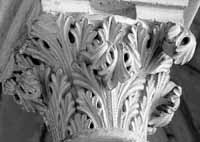 |
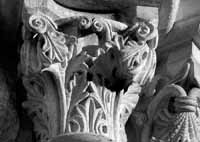 |
1113 | 1176 | 2c+ | SEE Pietro | Corner crocket or frond berry connected by one vine to central frond. Symmetrical and perfectly balanced after the crusade, not before. lower part of individual leaves are squeezed so they appear to jump outwards. Outwards movement aided by the sharp tips and the deeper scooping of the central veins. No creatures, mid-fan, 2 layers, loves deep cutting into the spaces between fronds and tips. |
|
Acanthe |
 |
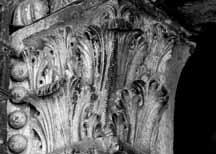 |
1133 | 1184 | f+ | Deeply drilled fronds very curled in many layers. Emphasised crockets with little drill-holes. Often with a ring around the middle. |
|
|
Adrien |
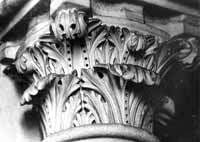 |
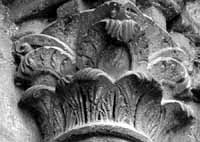 |
1129 | 1173 | 2c+ | SEE Benoit | Two layers of foliage around the cone. The upper being pairs of long fronds arising from the centre of the face with a space between them at the centre, and at the corners a deeply incised hollow, a bit like Palmier in structure. The lower layer of leaves lie alongside each other without any penetration. The major leaf is in the centre. The spines are split, though this does depend on the hardness of the stone being used. The tips push outwards and turn over, and after the early 1140s they formed projecting tables that cast significant shadows. The upper edge of the basket is displayed and above that there is usually an enchancre at the junction with the impost. There is a little drilling in later works. Has a continuousskirt, unlike Benoit where upper fromds emerge from the base. |
|
Apple I |
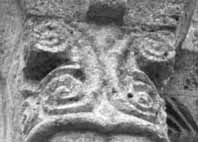 |
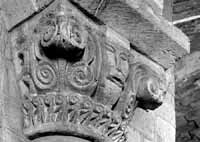 |
1075 | 1131 | r2f oo | SEE Gripple group | The tendrils of the whorl emerge to fall towards the base on each side to create symmetrical looped vines supporting inward-facing foliage in two upward facing fronds at the bottom. Tendrils independent of the base, seeming to float. Corner crockets are often quite large. Designs may be enlarged and enriched with other motifs, but this is always in the corners. Over time the lower fronds fill the space between the tendrils. Main encasing branches do not spread to the sides, an entire unit. Early works are thin and disjointed, and lead to the mature arrangements. Larger capitals are embellished with other forms, but in every case the trademark enclosure is used on the corners. These variations dovetails in time. |
|
Apple II |
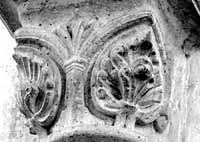 |
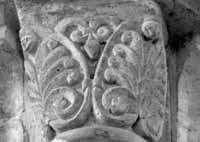 |
1072 | 1158 | r2f oo | Looped vines that do not cross, symmetrical on the corner with a point at the top and a large single foliate rising from the bottom. There are no crockets. Vines do not cross, but are lightly tied where they meet, and with a posy filling the upper space between. In Etampes nave one capital in the aisle has this form on same stone as a large presenting bouquet, and the two are joined with a collar. I suggest that in this campaign Apple II was one of Papillion&amp;rsquo;s apprentices and was given the job of completing the side of the capital [fourth image in Display 2]. They are in the same team working together as the two vines are tied together and the frame on the left begins on the inner corner of the same stone as the great bouquet on the left. This does not happen again and from here on Apple II creates capitals with his own template independently of Papillion. Some similars in basic outline but by different carvers [Display 3]. |
|
|
Apple III |
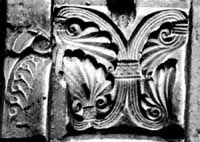 |
 |
1103 | 1162 | r2f oo | SEE Belting, Andre, Winger | Looped vines that do not cross, symmetrical on the corner with foliage top and bottom, the upper ones forming a projecting hood over the lower. Pending stage 3 of carver analysis. Fronds are contained within the frame of the branches. |
|
Apple IV |
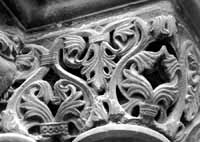 |
 |
1126 | 1143 | r2c oo T^ | SEE Gripple II tho more complex. Heron at sMdC. | Reverse arrangement to Apple III, with weight at the top-centre and branches tied and cross; long sheath at join of branches, esp in Saint-Martin-des-Champs (a trick of the 30s?). The foliage is contained within the frame, and as the selection is based on the primary structure being the heart-shape on the face of the capital, the rare occasions when the fronds enfold the branches may be through influence, one way or the other. |
|
Applique |
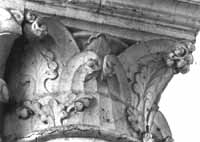 |
 |
1161 | 1186 | 2c | The plates start from the astragal and corner plates continue to a small crocket, even if covered at the sides. Placed a leaf on top of a plate and nothing in upper centre. One of the common ways to include foliage. |
|
|
Arum II |
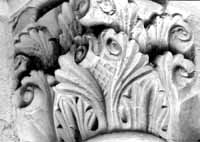 |
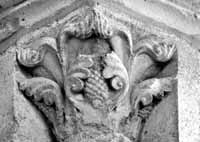 |
1126 | 1167 | 2f <> | Arum lily with large berry in centre, either on face or on corner flanked by splayed foliage and split leaves. The arrangements are densely packed with a lot of turning and folding and pointed tips. The berry is secondary and seems evolved from or emerges from the foliage. It is a secondary element. Only ones to use berries constantly are Arum I and II. |
|
|
Aubert |
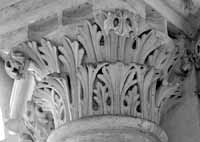 |
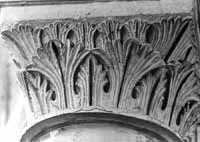 |
1155 | 1161 | 2c+ <> | Two layers of foliage forming a ledge with tips that project strongly outwards. |
|
|
Auguste |
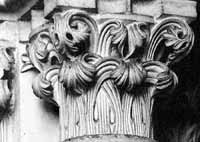 |
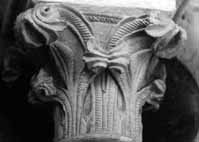 |
1140 | 1175 | 3X Tv | Straps like Gamma, but decorated with parallel veins and leaflets. May have spent the 50s elsewhere. More geometric in 40s. No creatures. Ex Laon gallery; strap woven |
|
|
Aviateur |
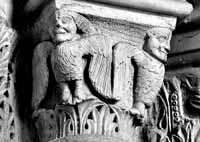 |
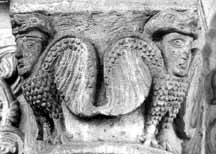 |
1138 | Bf | SEE Birdman; Pecker group, Nested, Peekaboo | Thick-bodied frontal bird on the corner with round head and raised wings that hang down at the tips, often flanked by foliage. He also carved sun-heads as both head and bird are on the same stone in the Bury nave. Many clones; increasingly skillful and detailed; no figures. It is worth following three restored capitals in Morienval, St-Leu-d'Esserent and Aulnay-sous-Bois. The shoulders and wings of some have been raised as if shrugging. The birds faces viewer, with large pair of wings, rounded at top, no leaves underneath. One capital in Bury has both the head and the bird carved on different corners. I have presumed that all the similar heads were by Aviateur rather than two carvers being engaged on the one stone, though I have separated them under the name of AxHead. Some have no face, but just the hairy surround. There is nothing second-rate in these heads. |
|
|
AxHead |
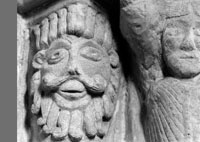 |
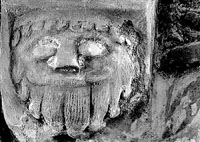 |
1083 | 1157 | H | SEE Aviateur | A head on the corner dominating the form. Hair often spread out to fill the space. Straggly beard. One is carved on the same stone as an Aviateur bird. |
|
Banniere |
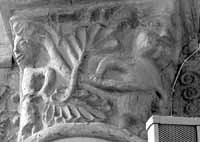 |
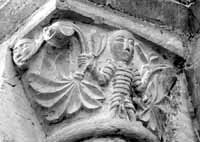 |
1071 | 1128 | tree | Used no single format, no standard template, but created each design from scratch. No symmetry is to be found and nothing overlaps. There is few empty spaces. The core design detail consists of a sprig of energized fronds expanding from a little collar, all held from the end of a twig or branch, like a fan. The lobes of the fan-like frond are scooped, with rounded ends, with minor variations in the lobes. A cloverleaf with three large scooped fronds may hang between the fans. There is no encasing form for the leaf as they simply terminate where most convenient. It is the similarities in the shape and detailing of the fan-like leaves that connect all these elements as the work of one carver. He began using heads instead of crockets in the corners, perhaps after working with the Old Duke in the St-Vaast-de-Longmont tower. There are two recent replacements that tried unsuccessfully to emulate his twelfth-century sang-froid in Deuil-la-Barre. Simple figures dominate the larger capitals in static poses, the heads enlarged and without expression. The scooped petals suggest he worked on small capitals in a number of towers. The Old Duke used similar finger-like foliage at the ends of long stems, and there are occasions when capitals could have been ascribed either way. I made the arbitrary decision that if the upper corner was occupied by a head it was the Old Duke, and if not by Banniere. |
|
|
Banniere II |
 |
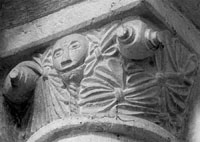 |
1082 | 1130 | tree | Different arrangements on each stone, but with large fronds with big open petals, There are no branches in these arrangements. Unlike Bannier where the ranch is an essential component, these are scoops of petals or hollowed leaves that stand independently of any structure. |
|
|
Baptiste |
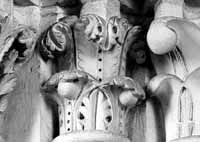 |
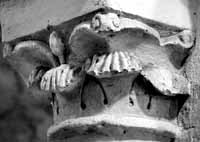 |
1113 | 1161 | 2c+ | Strong projections, in two rows, with the middle fan being the same projection as the upper. Two-level arrangement. |
|
|
Belting |
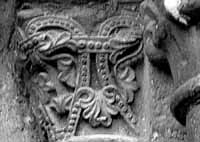 |
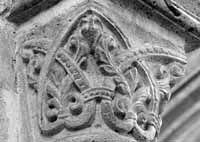 |
1103 | 1144 | r3f | SEE Etouffant, Apple II, Andre the Weaver, Heron, SS- | The straps in the core template start in the corner, with or without a crocket, and descend to form a lozenge that encloses and delivers the large fronds or branches that rise from the ends of the straps. The straps cross over, either from adjacent descending ones or from the ascending. It is a lively arrangement. In early designs the straps are tighter and more concentrated, but after the mid-1120s the crossing straps were loosened and less taut, in which the returning tendrils were replaced with a large leaf, so its quite a fuzzy affair. Then, a decade or so later, the taut design returned but within a more open and generous arrangement where the detailing is dense. There are affinities with Apple II except fronds and branches extended across the cone and cross one another in three-dimensional patterns. Possible earlier work and likely trip south to Fontevraud before returning to Chartres for a possible stint on the colonnettes of the portal. The process of change is clearer when seen all together. |
|
Benoit |
 |
1158 | 1161 | 3cX e<> | SEE Adrien | mid fan, woven, 2 layers corner open. Unlike Adrian, the upper fronds emerge from the base. |
|
|
Birdman |
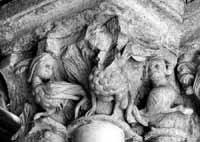 |
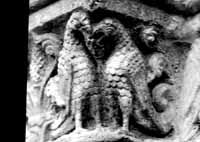 |
1128 | 1164 | Bf+ | SEE Aviateur, Pecker groups | Wide range of layouts, showing a mobile imagination. Fully rounded animals and birds set among leaves that start at the astragal. Birds stand on the foliage, face each other. Wings pointed up, it is the substance of the bodies and the use of foliage that sets Birdman apart from Birdman-up. The foliage rises up behind the figures to detach them from the stonework so they maintain some independence. Skin and feather surfaces carefully prepared and detailed. There is a vibrant presence in these figures, for they occupy the same space as we do, presenting a striking originality in the bodies. Human heads and their hair are endearing. Total symmetry often avoided by the small differences between the figures. Have not found any early examples of this mode. |
|
Birdman-up |
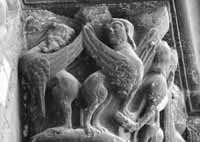 |
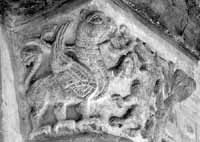 |
1108 | 1141 | Bc e | SEE Aviateur, Pecker group | Winged birds and other animals where the wings are very pointed and rise vertically. Foliage is non-existent except in Saint-Loup-de-Naud and Saint-Germain-des-Pres where he seems to have conformed to a higher authority. Bodies twisted, no leaves,pointed wings upwards. From the growing stylistic skills in his capitals it seems that he and Palmier both returned to the Paris Basin to work in Provins just before going to St-Denis where, beneath the restorations, one can see the self-control in the design. Progress in his skills during the 1120s would be in work not represented in the Paris Basin, but I have not located any in this manner in other areas. Later designs follow the same template, and become more mature and well-regulated. |
|
Birdman-X |
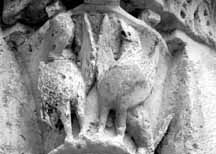 |
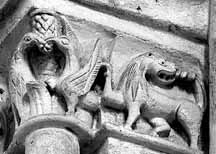 |
1082 | 1156 | B | Simpler carving than the other birds, stiff wings thrust upright. |
|
|
Blunt |
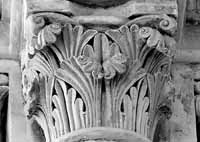 |
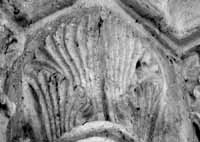 |
1136 | 1163 | 2c+ | Rigid parallel veins to unarticulated foliage |
|
|
Bouquet |
 |
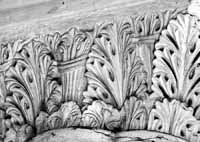 |
1118 | 1162 | 3c+ | SEE Daniel | Central posy of leaves with strong binder. Posy open wide. Tall leaf fills the corners, no crockets. |
|
Bowline |
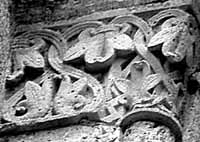 |
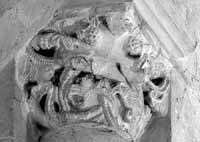 |
1109 | 1165 | r3f | SEE Entangle | Looping and crossing tendrils with more verve than geometry. The arrangement respects the importance of the corner. Over time the design approaches symmetry. Little leaves fill the spaces, but clearly the thickness and vigour of the tendrils take first place. |
|
Boxer |
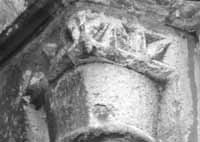 |
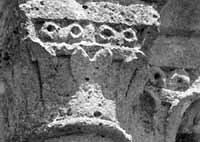 |
1076 | 1163 | + geom | Upper zone squared-off with decoration above and below. |
|
|
Bussiares |
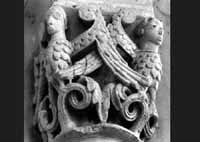 |
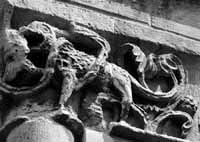 |
1157 | 1185 | Bf | Most recognisable template is birds frontal with separate wing that emerge from raised shoulder, as in a shrug, or a plate. Second template is of naive figures, heads and animals set among vines and tendrils, little design control though elements are paired. Detailing is stretched and angled to enhance the drama. Deeply undercut so design almost separate from the cone. Much the same throughout a working life. A very personal creation. |
|
|
Butterfly |
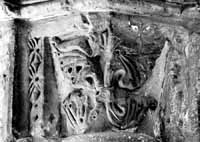 |
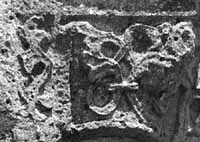 |
1082 | 1145 | leaf f | Guirlande | Paired leaves or bouquets place on the side or the corner, and tied at middle. the tips have a robust and somewhat flouncy appearance. Unlike Guirlande, these fronds do not rise out of a common vine, but are clasped together, as if being held i the hand. |
|
Button |
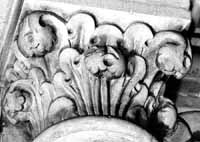 |
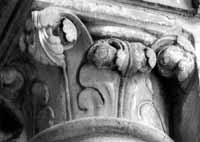 |
1159 | 1186 | 2c + | Round leaves with drilled junctions and scooped veins; often balls under crockets. |
|
|
Chrisomon |
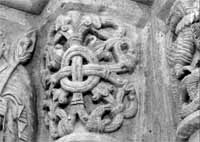 |
 |
1120 | 1164 | geom | structured, large figs |
|
|
Christophe |
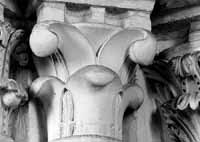 |
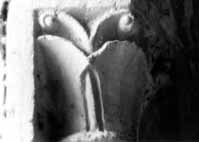 |
1160 | 1161 | 2c + | mid fan, 2 storey |
|
|
Clasper |
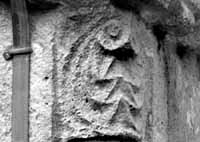 |
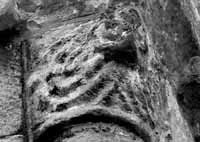 |
1082 | 1092 | hang | Corner crocket with multiple lines moving out from it to touch below, in earlier with points. Mainly on towers. |
|
|
Clement |
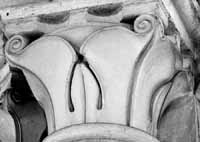 |
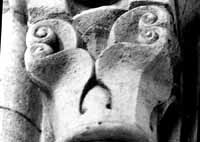 |
1122 | 1165 | 2f + <> | Herve, Pointed and Tortue | Corner fan, big mid leaf, tip turned back. The foliage is two-dimensional and 3-lobed with smaller central leaf. |
|
Coiffure |
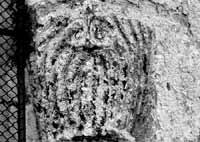 |
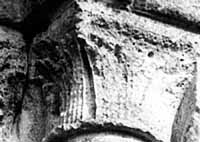 |
1078 | 1165 | geom | Thin vertical and parallel lines on either side of the corner crocket that appear to hang, like a head of hair. Lightly incised. |
|
|
Comet |
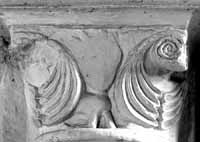 |
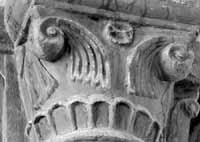 |
1076 | 1139 | hang | Tails attached to each side of the corner crocket so looks like comets trailing symmetrical wings. Sometimes the tails hang, or curl around to meet underneath the crocket. The spread of the tail often depends on the space to be filled between the corner and the middle, most evident in the smaller capitals. There are five phases of work depending mostly on added elements, found most often on larger stones where the proliferation of other details could have been his creation or he may have been following directions from the master mason. No creatures, except in one that may have been earliest in which the figure on the left may have been by another carver working on the same stone. His presence in one of the few original capitals in Morienval provides an impetus to push this choir closer to the First Crusade especially as matching capitals were carved in Acy-en-Multien at his time. |
|
|
Comet II |
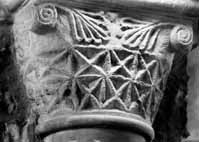 |
 |
1074 | 1115 | hang G | Spaced out version of Comet, possible student. The flare from the crocket is usually hung off a branch, and is often more horizontal where Comet's hangs vertically. Often a small clasp between the branch and the flare. He also includes a lot of decoration under the flare, often geometric. |
|
|
CometSon |
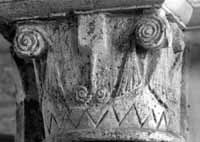 |
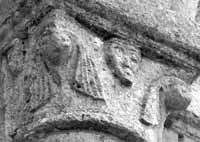 |
1091 | 1117 | hang | Comets with geometric silhouette and sharp edges. The fluidity has gone. Since these are only in the Vexin the carver may have been a local. Could this be someone working under Comet and using his template and after the Crusade carving these in acknowledgement that Comet had become Master of the works, as seems to have happened to Palmier? |
|
|
Complexitus |
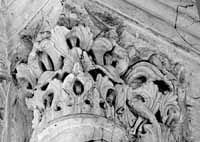 |
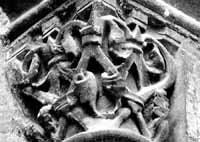 |
1110 | 1143 | r2c oo | A more complex and later version of Melinda becoming more rigid over time. A multitude of irregular elements lumpish in form held together with minimal branches and later a central trunk from which spread branches of support. Avoids vacant spaces. |
|
|
Counter |
 |
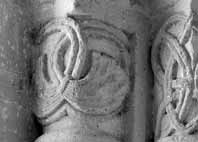 |
1102 | 1110 | r3f HSp | crossing circles placed on the corner |
|
|
Countess |
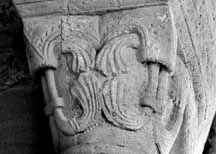 |
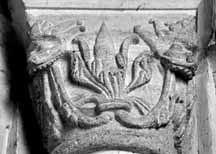 |
1080 | 1117 | r2 H | The earlier Duchess with head on the upper corner and fronds descending from the mouth in vertical strands. Instead of these then turning outwards into spirals they rise straight up to display leaves. In both the decor is to each side of the head, not below. |
|
|
Coverall |
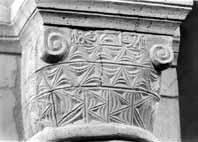 |
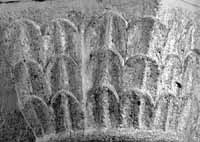 |
1073 | 1118 | geom | Surface rounded in the simplest conical form and then covered with repetitive patterns. There may or may not be corner crockets. |
|
|
Curly |
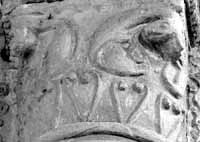 |
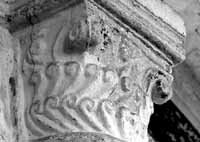 |
1073 | 1126 | hang | Multiple long tendrils with curled ends. Becomes more complex in organisation in the late 1080s. Other elements added in the style of the project. |
|
|
Curtains |
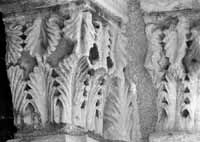 |
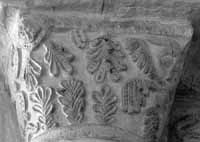 |
1083 | 1160 | 2# + | Francoise, the Hangers, Lapwing | Two rows of finely carved fronds, with pointed ends and deeply undercut. Fronds are 'held' in pairs from behind. The upper row is smaller, occupying about 2/5ths of the height. |
|
Cyprian |
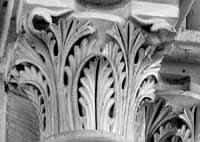 |
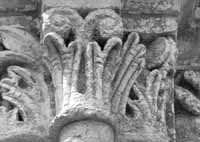 |
1130 | 1164 | 2f <> | Tall, almost full-height central leaf, flanking fronds with lobes facing outwards that start halfway up the capital,. Nothing overlaps, but all leaves are from a two-dimensional set out. There is usually a wide gap through the centre of the leaf, so that space takes the place of the spine. An earlier stage with simpler leaves, pointing up under crocket. Corner-fan, big mid leaf, mid-frame, tip turned back in a most elegant frond. |
|
|
Damien |
 |
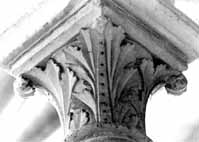 |
1160 | 1188 | 2f <> | One of the Cog Masters with finely inscribed veins and the fronds overlap and even poke outwards.. No creatures. Has corner-fans, tiny until later work, In a later capital in the south Laon gallery he reverts and omits the central leaf. |
|
|
Daniel |
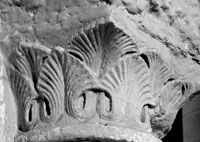 |
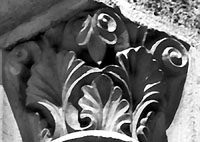 |
1113 | 1160 | 3c+ <> | like Sprout |
|
|
Denis |
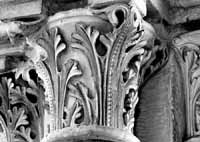 |
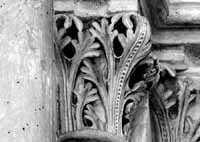 |
1161 | 1161 | 2f <> | corner-thin, teeth, tip turned back |
|
|
Dominique |
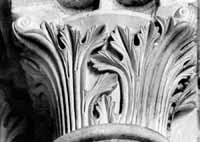 |
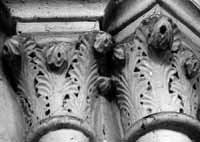 |
1159 | 1178 | 2f <> | Large corner-fan with intersecting, teeth like cogs. The smaller central leaf laps over the larger corner leaves, with the fronds lying on the surface of the other. The spines are deeply grooved and the waist of the fronds gets wider with less waisting as he gets older, as in Canterbury. There is a tendency for the spacing to become more open in time. The tighter designs are in the 60s, the looser towards the end of his life. |
|
|
Dowager |
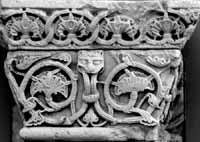 |
 |
1108 | 1155 | r2c HSp | Head in centre of the side, symmetrical tendrils in various forms,preference for long leaves. Head never more than half the height. |
|
|
Drago |
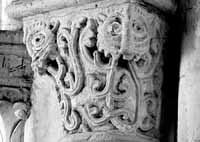 |
 |
1111 | 1153 | r2f H | Large square head, often crowned, wild in form, eyes enlarged. Tendrils disorderly, non-symmetrical. |
|
|
Droopy |
 |
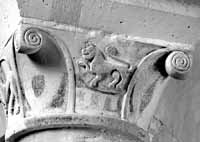 |
1075 | 1155 | hang | SEE Zacherie | Large crockets with lateral vines that descend to the astragal. Second group with animal and plant infills in the spandrel, some with considerable additional decoration that appears to have been a job request. Later ones possibly a team. |
|
Duchess |
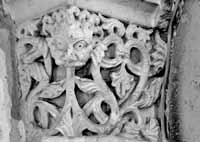 |
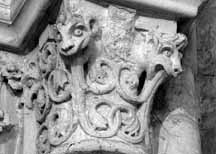 |
1118 | 1143 | r2f H | SEE Felix | Heads in the upper corners with tendrils and leaves emerging vertically from the mouth and turning away from each other to fronds on either side. The foliage is then the Duke and wilder. The axes of symmetry lie at the corners. He enjoyed curves, and entwined more than he wove. The socket on the vine has a little opening out of which a lateral tendril emerges. Learned to control the curves and symmetry of the elements, and his detailing became more delicate. He increasingly complicated the arrangements and enriched the foliage. Entangled birds with wings held close. |
|
Duke |
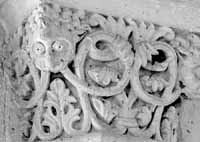 |
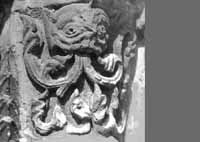 |
1105 | 1146 | r2f HSp | SEE The Old Duke, Duchess | Heads in the upper corners with tendrils and leaves emerging from the mouth, at the astragal they turn back and inwards to support upward-growing foliage. Adjacent branches are joined with a small buckle. The axes of symmetry lie at the corners. He enjoyed curves, and entwined more than he wove. He learned to control the curves and symmetry of the elements, and over time his detailing became more delicate. The many copies, restorations or replacements are separated. He increasingly complicated the arrangements and enriched the foliage, though there are earlier ones that may be Duke too, with imposts ion the next. |
|
DukeSon |
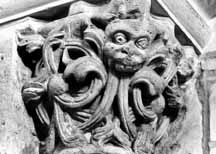 |
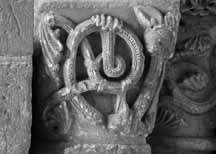 |
1109 | 1162 | r2f H | Heads in the upper corners with tendrils and leaves emerging at an angle from the mouth, at the astragal they turn back and outwards (not inwards as with the Duke) to support upward-growing and curvilinear foliage. There are no buckles. Fronds are overlapped. |
|
|
Earwig |
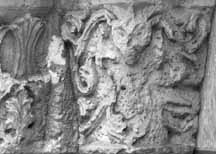 |
 |
1082 | 1142 | r2f H | head in corner with fronds emerging from the ears; centralised and symmetrical around the corner |
|
|
Embrun |
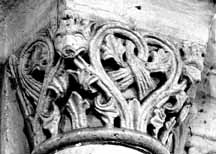 |
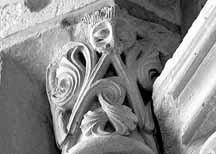 |
1125 | 1168 | r2c H | straight branches from mouth, angled to sides with soft entwined rinceaus on each face. |
|
|
Entangle I |
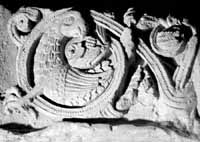 |
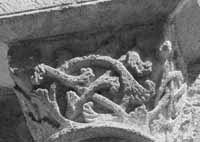 |
1118 | 1138 | r3c Sp | like Felix but more precise in detailing. |
|
|
Entangle II |
 |
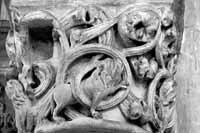 |
1169 | 1169 | r3c Sp | a more confused version of Entangle I |
|
|
Entonnoir |
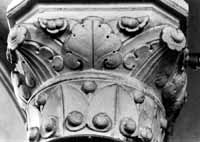 |
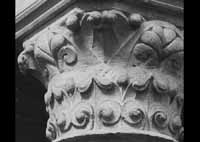 |
1200 | 1208 | 2c# | Massive elements that appear bolted together, with little connection between them. Set out in two layers with different elements in each. Bulbous lower parts of leaves. |
|
|
Entract |
 |
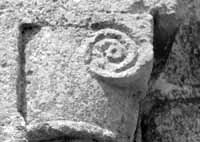 |
1075 | 1168 | cone | SEE Etouffant for upper central extension | Dominant crockets over cylindrical cone, undecorated. Simple squared top. A number of men. |
|
Esteban |
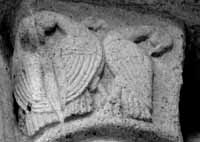 |
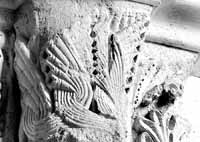 |
1085 | 1167 | Bx lines | Flat surfaces covered with many parallel lines. Pending stage 3 of carver analysis. |
|
|
Etienne |
 |
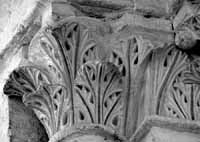 |
1122 | 1166 | 2f+ <> | mid-plate, 2 layers |
|
|
Etouffant |
 |
 |
1080 | 1124 | cone | SEE Zac, Entract, Headman for the castellated version | Like Entract but with centre of cone extended to abacus. Large crockets, plain purely conical surface underneath crockets to base, and central vertical extension. |
|
Eugene |
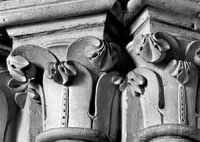 |
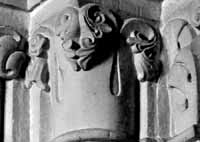 |
1157 | 1168 | 2c <> | 2 layers |
|
|
Fabian |
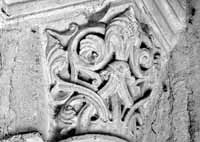 |
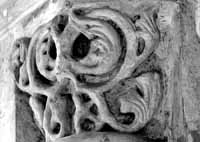 |
1112 | 1162 | r3f oo | skilled sculptor, derives the branches from a solid base, and moves symmetrically around the corner. |
|
|
Fabrice |
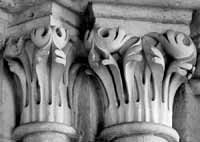 |
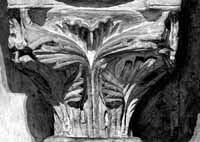 |
1115 | 1181 | 2c <> | The key elements are ribbons in he Gamma manner that are linked at the bottom, vertical tips mixed with those that hang, and occasionally berries on tall stalks. Very skilful. No creatures. Ex Laon gallery, pending stage 3 of carver analysis. |
|
|
Faceter |
 |
 |
1085 | 1128 | cone | Twelve to eight sides at the base, rising to support a central panel or decoration. The lower two-thirds is undecorated. Cartouches etc added in upper centre or the 'V' cleavage emphasised with decorative edges in middle years. Crockets are large, curled and almost symmetrical. No creatures. There are many minor decorative items that could be by this carver or than his crew, though do not forget those that have been restored. Two or more facets on each side become slightly concave in a few later capitals. Altogether this makes for a formidable collection and gives some idea of how many capitals of the simpler sort could be carved in a lifetime. More than a hundred survived from the work of over 40 years. |
|
|
Fanny |
 |
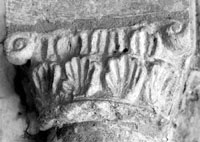 |
1068 | 1172 | 2# + | Splayed leaves with clearly marked central spines, separated and placed in rows around cone, inscribed veins and a little drilling. Less articulated in time. No creatures. Each leaf distinct. Fair;y sha;ow cutting between them. |
|
|
Fathead |
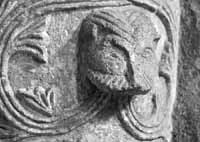 |
 |
1069 | 1153 | H | SEE Fathea with head squeezed into the middle | Very large heads in the corners. Not much change. No creatures. Two generations. |
|
Felix |
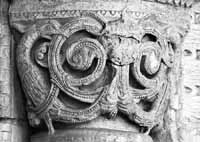 |
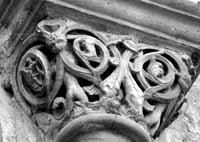 |
1089 | 1156 | r3f HSp | SEE Melinda | Spirals are a major structure. Little leaves of similar designs on long stems stick out from the spirals. The side branches emerge from sockets that do not cut across the main branch, a personal device. Animals are always contained within branches, enfolded in the vines, but never entangled. His most notable personal feature is a man with arms wrapped around the vines. Figures and animals are seldom in pairs, but each is self-contained within the enfolding vines. Tails may be curled or merge into the branches. The spiral and animal combinations are a favourite way to decorate imposts, friezes and archways. Heads in the upper corners have a pair of vines emerging from the mouth that move apart into symmetrical spirals that end in small leaves or rosettes. These rosette may contain heads, a device shared only with Gregoire. Vines and fronds may also come out of the ears. A magnificent observer throughout life without great changes over time. People are always frontal, birds may have upswept wings. Felix seems to have travelled a lot. |
|
Festoon |
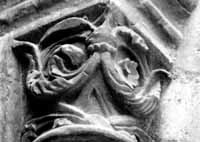 |
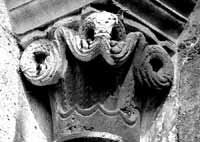 |
1083 | 1164 | skirt | SEE Palmette | Drooping bouquets in the upper corners, becoming heavier in time, spotty designs. Sometimes heads as crockets. May include stretched animals. |
|
Fiesta |
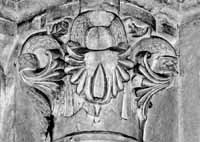 |
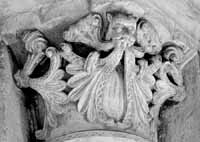 |
1130 | 1167 | hang | SEE Flopsie. Could be Ouvert. | Pair of large fronds that are very scooped out falling downwards, occasionally held at the top with a clasp. This is a powerful and individual concept that has few copiers until after the Crusade, when it seems like there were a number of carvers. In the earlier collection most of the capitals seem to have been the work of one man. |
|
Firedog |
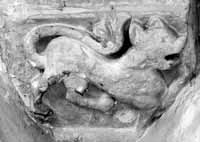 |
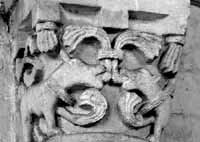 |
1085 | 1165 | H | Animals with very fluid bodies, sometimes breathing fire. Not as well organised as Willowâs. Pending stage 3 of carver analysis. |
|
|
FlatStrap |
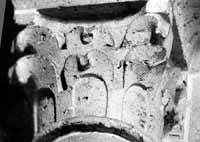 |
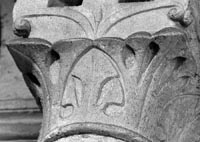 |
1081 | 1175 | 2+ e | various elements joined by flat straps that intersect over unadorned but very varied lower forms. |
|
|
Fleurette |
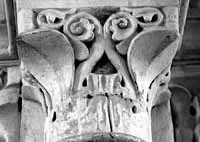 |
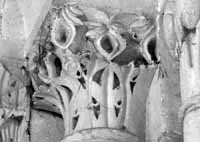 |
1115 | 1162 | 2f+ <> | Or Duchess or Papillon |
|
|
Flopsie |
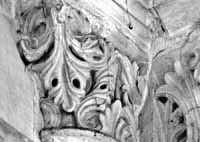 |
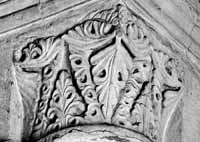 |
1108 | 1168 | 2f | SEE Fiesta | Large corner leaves, half height or so, hanging from a twig at the upper corner. Often works in the manner of the shop. |
|
Florentin |
 |
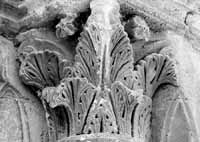 |
1113 | 1160 | 2f + | SEE Lissier, Lapwing | Verticality emphasised. Layers, unlike Lisier. Strongly projecting leaves with deeply scooped veins and deep gaps between the fronds. Over-tall upper frond. No roll or fold-down under corners. No overlapping. Crockets in later work. No creatures. Pending stage 3 of carver analysis. |
|
Franck |
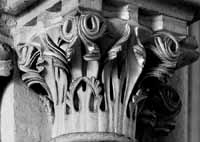 |
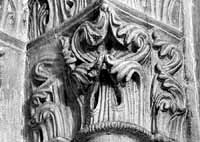 |
1129 | 1169 | 3c T^ <> | corner thin, woven, mid-frame, tips up |
|
|
Francois |
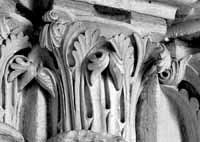 |
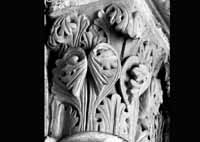 |
1144 | 1168 | 3c+ Tv <> | Curtains, the Hangers, Lapwing | corner thin, woven. Terminals hand with pointed fingers touching. Very elegant feeling to the design. |
|
Fretter |
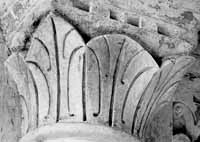 |
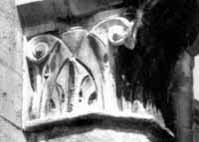 |
1132 | 1165 | 2c <> | Vertical | Like fretwork on a thin board. Design is two-dimensional with minimal surface decoration, the main form consists of two arcs that define the large flanking plates and the smaller in the middle; These plates are always divided with smaller fronds; the join between the forms is merely an incised line that ends in a little drill-hole. Inevitably this leads to sharply pointed leaves, but this only emphasizes the fretwork quality. Gradually the edges become a little more rounded, though this could be the work of an assistant. |
|
Frothy |
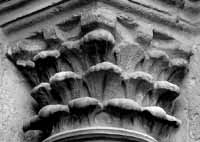 |
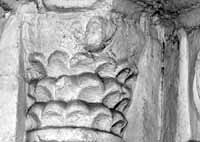 |
1074 | 1156 | 2#+ | SEE Lazare, Severin | Many small features in rows around the cone, opening to a space under the corner for a head or some element, sometimes in the middle. Many generations. |
|
Gamma |
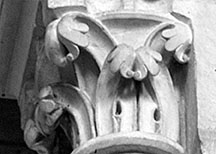 |
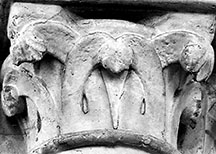 |
1130 | 1182 | 3X <> | Strapper, | Separate pairs of overlapping fairly wide straps in the shape of the Greek letter gamma with a generous curve between the verticals. They are consistent in form and detailing, mature rather than clever, with clear geometry and beautifully articulated members. Little change. No creatures. Ex Laon gallery, pending stages 3 and 4 of carver analysis. |
|
Garp |
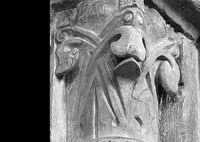 |
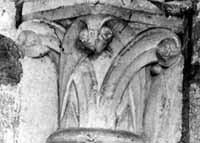 |
1112 | 1189 | 3X | Strapper etc | Thin, wider at the top ending in enlarged crockets. Often groove between straps. Denser than Gamma and without gentle curves between straps. |
|
Gaston |
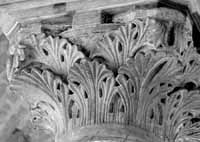 |
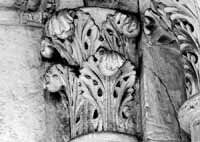 |
1142 | 1161 | 3c <> | , 2 stories, |
|
|
Geometer |
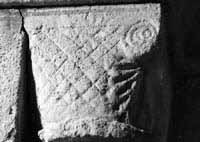 |
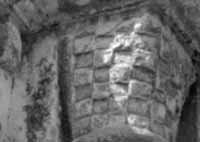 |
1075 | 1159 | geom | geom |
|
|
Gervais |
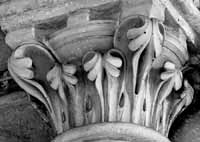 |
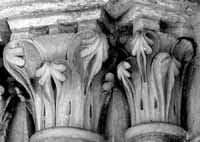 |
1161 | 1161 | 2c <> | woven, hanging tips, overlap |
|
|
Gregoire |
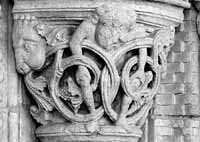 |
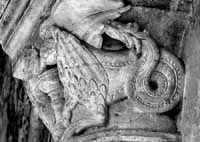 |
1104 | 1143 | r3c HSp | One of the most difficult to define as his templates are varied and depend on circumstances. Symmetry is non-existent. He prefers spirals like Felix, and is many ways like him, but more refined in his tendrils and more spectacular and unexpected in foliage. I set him apart for his individuality (though that could mean we are dealing with a number of men). His fronds are extraordinarily personal, seldom using any of the more common foliate forms, for they have intricate and wide outlines, with many sharp lobes. They may be drilled along the edges and the tips turn back on themselves, they may have protruding berries and large encasing pods. He followed the nature of the leaf that he set within an idealized vision. His figures, both people and animals, are set among twisting vines so the vine is as well held by the arms and legs as the figures are held by the vine. They are not trapped, but restfully climbing among them. Clothes do not get in the way as the figures are nearly always naked with empathetic rounded forms. Even women are naked, which is extremely unusual in this period. The differences with Felix lie in the refinement of the vines and the unexpected variety in the foliage, and above all the characterisation of the faces. A number of carvers worked under him in the colonnettes of the Royal Portal, using his template for figures and vines, but with very different handling of bodies and leafage. Many sequences of vines begin out of a square-faced mouth of a lion. |
|
|
Gripple |
 |
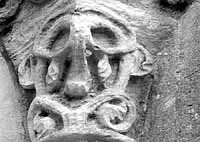 |
1105 | 1158 | r2f oo | The tendrils form a ring placed around the corner of the block, never on the face. Adjacent rings may touch, but are not connected, unlike SS II or Heron. At the top, the vines turn down to display a bouquet of five or more fronds. The upper pair of fronds expands slightly and turn backwards like little fingers, usually lying on top of or around the ring. The next pair passes under the ring and grips it tightly. There may be another pair, and finally tip of the one at the bottom turns back before touching the ring, and was often split down the centre. The effect is like a wreath. The vine may have a chock between the bottom of the ring and the astragal. The tendril itself is articulated with a central rib and the leaf outline is enlivened with three tips. Early designs were loosely organised and gradually became tighter, more exuberant and sinuous. No creatures. |
|
|
Gripple II |
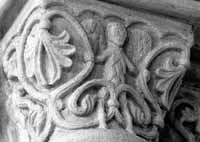 |
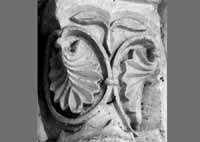 |
1105 | 1166 | r2f oo | Flatter more pendulous version of Gripple |
|
|
Gripple III |
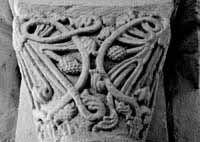 |
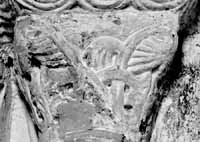 |
1105 | 1174 | r2f oo | Gripple manner, but with closely clustered long fronds. |
|
|
GrippleSon |
 |
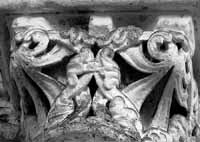 |
1155 | 1168 | r2f oo | Similar template to Gripple, with consummate skill, flamboyant and exceptionally three-dimensional. The ring of branches are not joined or rooted at the bottom. Tips very pointed and often turned back. Compared to SS II the corners have long tendrils sweeping down to the bottom edge. |
|
|
Grossteste |
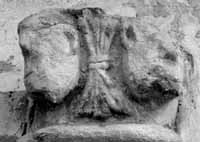 |
 |
1084 | 1173 | H | Massive heads usually in corners with little other decoration. Varied. A number of carvers involved. |
|
|
Growl |
 |
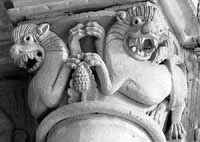 |
1112 | 1167 | H | A head with mouth open and many teeth on the corner; a three-pronged leaf; the plages underneath arfe divided by a simple vertical groove. A certain ungainly extravagance. |
|
|
Guirlande |
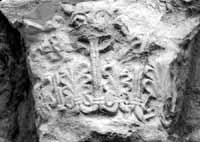 |
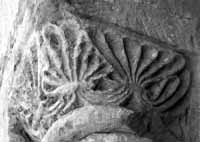 |
1074 | 1134 | 2# <> | SEE Butterfly | Posies of upward-pointing finger-like fronds tied with bands and joined together along the bottom. In later years integrated into grilles and other geometric frames. Occasional heads. Compare with Butterfly where the approach is completely different. |
|
Hanger |
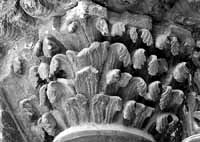 |
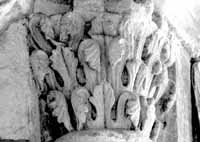 |
1105 | 1141 | 2# Tv | Francoise, Curtains, Lapwing, Severin | Three or more rows of fronds hanging down. Sometimes vertical upstanding fronds between the hangers, but these are set back. no crockets. |
|
Hanger I |
 |
 |
1112 | 1137 | 2# Tv | Severin | Multiple hanging leaves in rows. Different types of leaves and tips. Pending stage 3 of carver analysis. |
|
Hanger II |
 |
 |
1129 | 1167 | 2# Tv | hanging fronds more natural and flattened onto the cone. |
|
|
Headman |
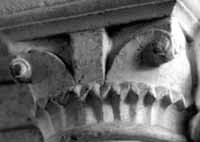 |
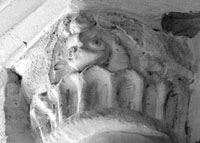 |
1137 | cone # | SEE Etouffant for the plain version | Number of generations. Large crockets, plain surface underneath, and central vertical plate, and always with a castellated ring around the base. Others decorate the spandrels. |
|
|
Headman-2 |
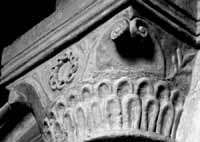 |
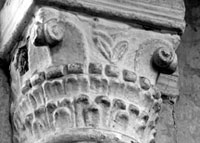 |
1074 | 1123 | cone # | More decorative version of Headman with two or more rows across the bottom and floral etc elements across the top. |
|
|
Hercule |
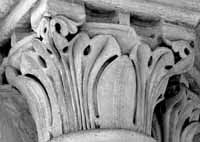 |
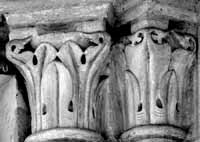 |
1161 | 1161 | 2f <> e | corner fan , tip turned back |
|
|
Heron |
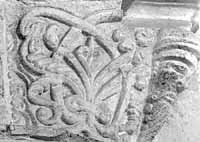 |
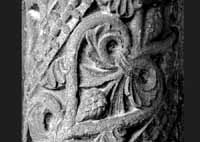 |
1104 | 1164 | r3c oo | SEE SS, Rameau | The core design consists of a pair of loops that double back to frame a posy of five fronds. Three fronds point upwards, and two fall sideways. The bouquet carries a hint of the fleur-de-lis to come. Fronds may or may not cross the looped vines. Vines may or may not cross one another or be tied. When the form is taller the vines may be continued upwards to repeat a second group of fronds that hang downwards. Some fronds are shaped like the neck and head of a heron, narrow where it joins the main branch and expanding to the tips. They are placed so that they pass alternatively over and under the tendril. The lobe at the bottom of the posey is bent over to provide some three-dimensionality, and at the top meets the stalk in a bud or a point that was twisted backwards. In small units these are like a cartouche. The curves are pleasing. Would at times place the frond over a plate like a frame. At the junctions the smaller tendril emerges from larger with a tie that looks like rope. Animals are woven into the design in the same way. Connections with possible earlier work are not very secure, and neither are the capitals carved by 3 others in what seems to have been a Recognition. In tall friezes the vines are woven and the bouquet fits within this primary pattern. |
|
Herve |
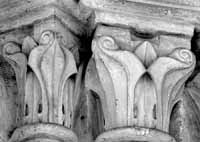 |
1158 | 1161 | 3f <> e | SEE Jalons | woven, , tip turned back, unlike Pointed where tips are outward and plain points. |
|
|
Hooker |
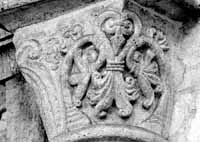 |
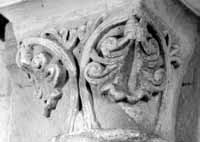 |
1107 | 1167 | r3f oo | Bouquets hang off the corners and fronds end in hooks. Some tendrils bound with a band. Orderly where Rameau is more random in arrangements. Large animals flanked by foliage with hooks, not entangled in it. A small oeuvre. |
|
|
Horace |
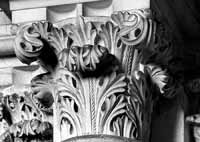 |
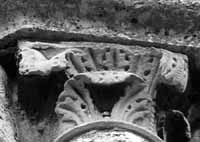 |
1133 | 1163 | 3c <> | woven, 2 layers, with thick fronds and 3-lobed petals. drilled, aa in Chars. |
|
|
Hugues |
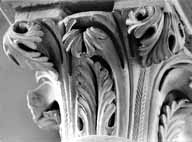 |
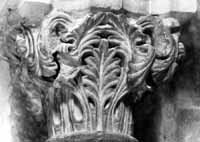 |
1134 | 1170 | 2f <> | framed corner, , |
|
|
Igor the Mad |
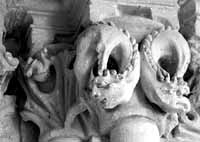 |
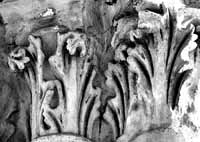 |
1133 | 1169 | 2f H | One of the Cog Masters with overlapping tips and very projecting edges. Every element over-developed. Projects the crocket beyond the abacus. Animals turning and twisting with enormous energy. Pending stage 3 of carver analysis. |
|
|
ImpostO |
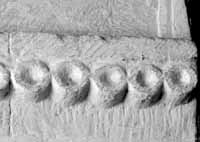 |
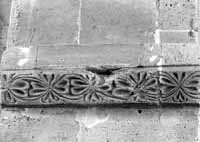 |
1078 | 1088 | geom | Impost across full width of pier without any capitals underneath, decorated with geometric designs. |
|
|
Isaie |
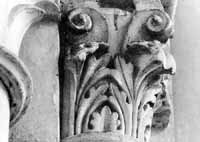 |
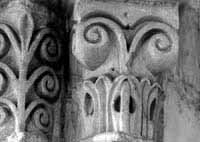 |
1107 | 1165 | 2f+ <> | SEE Festoon, Palmette | 2 stories, foliage below and well defined crocket above. |
|
Jacques |
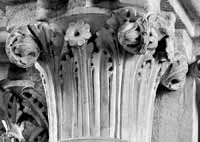 |
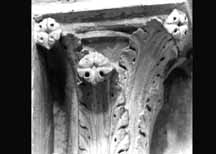 |
1161 | 1184 | 2f+ <> | Crockets with flowers and drilling between the petals. There is always one in the centre. These are two-D arrangements with minimal connections at the base. Foliage becomes simpler in time. |
|
|
Jalons |
 |
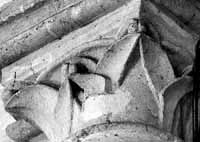 |
1152 | 1164 | 3f <> | SEE Herve | triangular plates instead of curved, as was normal. sharp angles. Plates meet at points. |
|
Jeremy |
 |
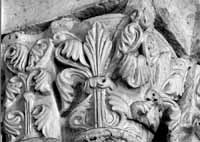 |
1109 | 1160 | tree | Locates a point in the exact middle of the face, and then moves in all directions from that, at least in the earlier work. This is where the small collar is placed. In some, mainly earlier work, two straight branches to the astragal support a posy of five or less leaves, often with a central berry or flower in a combination of upward-pointing tips and downward. Abacus almost never enchancre, but straight. Bundles of leaves, usually 5, bound in the middle of the face, with the leaves closest to the band turned sharply down. From La Ferte-Alais designs became increasingly fanciful yet held in close to the inner structure. The parts are more stiffly drawn than Jerome in which the large fanciful leaves hang outside the structure, and the bouquet was less relevant. Possible essays as an apprentice in early examples. |
|
|
Jerome |
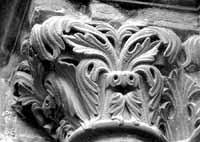 |
 |
1123 | 1161 | tree | Symmetrical, large rosette-collar of three fronds with large holes between them is a major identifier. It ties two straight branches that bend in time, and above a posy of five or more vigorous leaves some of which hang down. Abacus usually acute;. Vigour becomes florid, surfaces more detailed. Winged dragons, lions and birds, some with human heads, wings upward, tails curled and usually place back to back with heads turned to face each other. Birds peck with a claw holding a mans shoulder. Heads beautifully modelled and individual. Compared with Jeremy where the fronds are tightly organised, Jerome has large fanciful leaves that hang heavy from very curved branches. The subtlety of his craft is demonstrated in complex arrangements in Angers and Chartres. |
|
|
Joel |
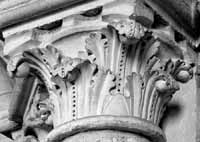 |
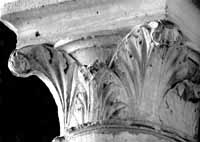 |
1158 | 1177 | 2c+ <> | mid-plate, , 2 layers, |
|
|
Joseph |
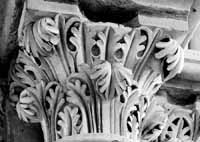 |
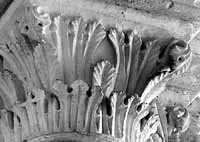 |
1155 | 1167 | 2c+ <> | mid-fan, flat top, 2 stories, |
|
|
Jumper |
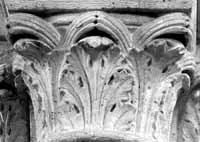 |
 |
1087 | 1167 | 2c+ | large central leaf with sprigs jumping up into the astragal |
|
|
Knotter |
 |
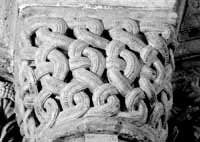 |
1087 | 1135 | geom | Applied to entire surface. Tight organisation of thick vines that overlap with minimal spaces between. Pending stage 3 of carver analysis. |
|
|
Kraken |
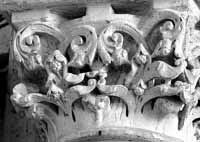 |
 |
1139 | 1174 | 2f+ <> T^ | ingenious arranement, fronds with roune-ended tips, the upper part more complex than the lower; startling in its complexity. |
|
|
Lapwing |
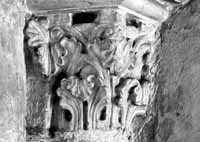 |
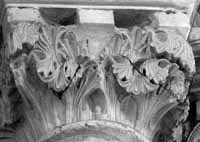 |
1118 | 1142 | 3f+ <> | SEE Florentin, Lissier, and Francoise, Curtains, Lap | A vigorous design with swinging connections between the leaves, at least in the earlier capitals. The junctions between leaves are formed as large openings from which the adjacent leaves then overlap. Foliage is rumbustious, quite extraordinarily rich three-dimensionally, with complex tips in contrast to the simpler veined supporting foliage underneath. The veins are long with close-set parallel lines that are simple where they start at the astragal, and spread out into the terminals. There is nearly always a small triangle under the drilled junction between leaves. Explosive quality in some later work where foliage swirls and juts into the spaces without the self-restraint later. No creatures. |
|
Lapwing II |
 |
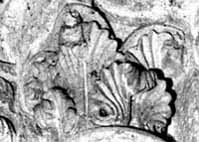 |
1133 | 1154 | 3f <> | same basic layout as Lapwing but with very simplified foliage, even ourline. has the same drilled gap at the junctions (though not as large) and none of the exhuberant dynamism. |
|
|
Lattice |
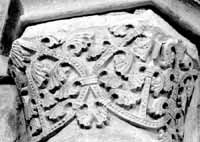 |
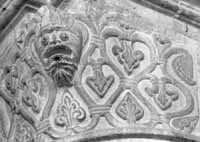 |
1075 | 1146 | 2# H | Overall latticework of vines joined, not lapped, and with decorative leaves filling the spaces; stalks are straight and dont overlap. |
|
|
Laurence |
 |
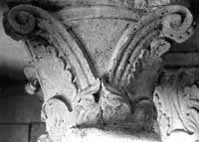 |
1144 | 1175 | 2fV <> | strap, framed corner, corner leaf, |
|
|
Layered |
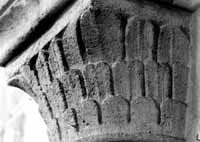 |
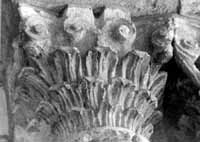 |
1164 | 2#+ | Rows of small fronds with the lower row covering the bottom sections of the upper. There may be two rows or more. Where there are single leaves forming vertical strips see Palmette. There are no crockets, no foliage. |
|
||
Lazare |
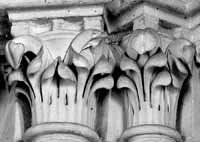 |
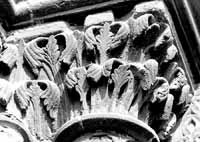 |
1127 | 1165 | 2f <> T^ | SEE Frothy, Severin II. | Tips quite refined, turn upwards over a large sack-like element. There is vigour in these forms. Placed horizontally, unlike Severin II. No creatures. |
|
Lissier |
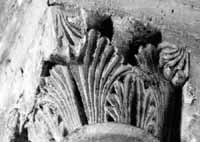 |
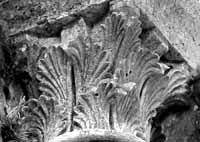 |
1108 | 1160 | 2f+ <> | SEE Lapwing, Florentin | Palmier fronds and layout, but to a level surface, not projections, so follows the cone of the capital. Pending stage 3 of carver analysis. |
|
Lobelia |
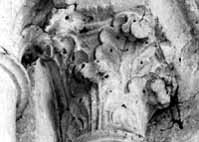 |
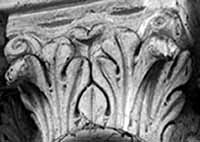 |
1162 | 1177 | 3f | SEE Vertical | Lobes of leaves rounded, slightly overlapping with clear drilled junction; plain with just one vein or spine; crockets formed the same way. No flower crockets. |
|
LongLeaf |
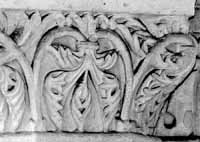 |
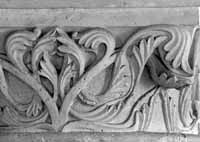 |
1109 | 1165 | r2f Tv | The modified design suggests a second carver after 1140. The branches never cross over one another nor do the leaves overlap, but pass alongside, either tied or untied. The leaves are long and thin, and little buds poke out of the tendrils and fill the space under the corners. The long fronds, the wavy forms and apparent casualness is disarming. There is, on close scrutiny, a powerful sense of control throughout. The symmetry is perfect, but disguised under the business of the parts. No creatures. Earlier trials in Angers depicted. Does not overlap. |
|
|
Loopy |
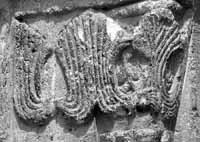 |
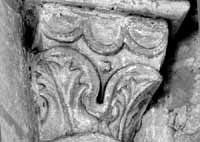 |
1072 | 1165 | 2f <> | SEE Olive | Two generations. Large vertical forms with long parallel veins that connect at the bottom with a loop providing the same thickness within the leaf and around the join. In some, this join is enlarged into a full circle in the manner of Victoire. Frond-like, plates covered with veins. |
|
Lucien |
 |
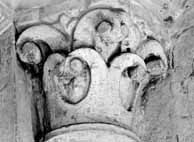 |
1125 | 1165 | 2f+ <> | corner-fan, mid-frame, , |
|
|
Lunge |
 |
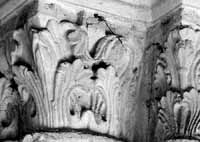 |
1128 | 1160 | 3f+ <> | A foliate idea where the tips turn over to form a frame for a space or a leaf underneath. Pending stage 3 of carver analysis. |
|
|
Marcel |
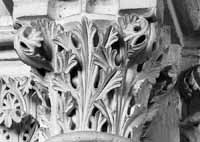 |
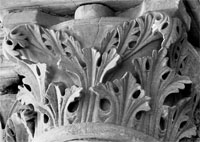 |
1161 | 1165 | 3f+ | Metalico ? | One of the Cog Masters with overlapping tips. Terminals large, hollow and flamboyant. No creatures. Ex Laon gallery, pending stage 4 of carver analysis. |
|
Matthieu |
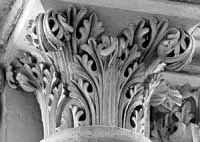 |
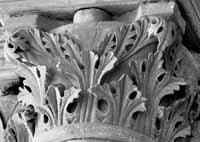 |
1159 | 1161 | 3c+ <> | mid-fan, , 2 layers, |
|
|
Maurice |
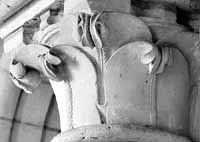 |
1161 | 1161 | 2c <> | mid-plate, , , |
|
||
Meander |
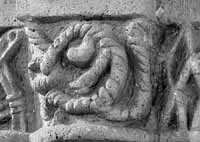 |
 |
1078 | 1164 | r3 | SEE Melinda | Branches arranged without order or sequence, except to fill the space. They begin anywhere and there are no heads. May cross. Rudimentary leaves that fillspaces without overlapping. . Becoming more orderly. Where spaces are filled |
|
Melinda |
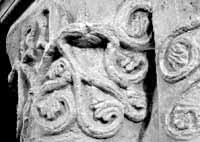 |
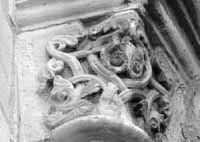 |
1072 | 1172 | r3 | SEE Meander | Many generations. Branches and leaves without order and just added onto each other, without junctions. Branches may begin in a head and encase foliage. Leaves set into spaces between fronds. |
|
Metalico |
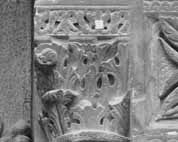 |
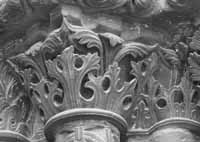 |
1129 | 1175 | 2f+ <> | Marcel ?? | Sharp-edged and undercut foliage that looks as if cut from tin. |
|
Multiplate |
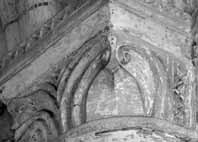 |
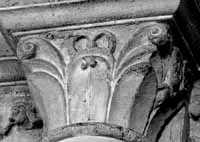 |
1159 | 2f | Simple plates laid over one another on the corner. there may be decorative niceties up the centre. |
|
||
Nazaire |
 |
 |
1124 | 1165 | 2f <> T> | Tall pointed plates under the corners with ribbons alongside that extend into the terminals, and turn down and back with long tips that merge into a central element, either a berry or a pair of fronds. The corner would have normally supported the crocket, but has been edged open so the terminal is disengaged from its support. The strap under the terminal lies parallel to the corner leaf. It supports, but only by implication, as it is too thin to be reliable. No creatures. |
|
|
Nested |
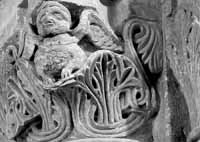 |
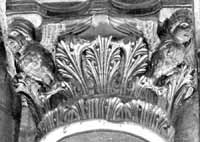 |
1112 | 1162 | Bc+ T> | There are figures of birds with human heads that are supported out of a band of foliage, like a nest. The figures seem to grow out of the cone, as if part of the stone. The postures have a certain formality, as all are presented frontally, with outstretched wings that assert their presence. They are in complete contrast to figures by Birdman that have a realism that is lacking in Nested. Some of the earlier ones have horizontal figures squashed into the space under the impost, either an earlier template or another caver [Display 5]. The later ones are taller and more tightly organised above skirt of leaves. They face us, outwards, with wings spread - two modes, flexible and stiff. |
|
|
Nicolas |
 |
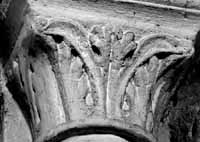 |
1133 | 1176 | 2fV <> | SEE Yves | Strap, framed corner, corner leaf, thin elegant edges. A refined arrangement in. which the straps enfold the corner leaf that fits in under the corner crocket. . |
|
Noel |
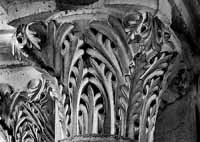 |
 |
1161 | 1169 | 2f | corner-fan, no middle, , |
|
|
Norm |
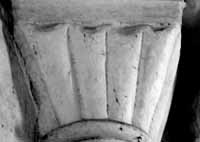 |
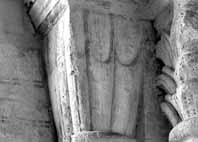 |
1075 | 1161 | geom | Vertical cylinders expanding to the top and without further ornament. |
|
|
Oda |
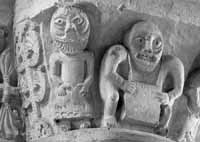 |
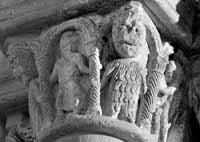 |
1068 | 1146 | H | SEE Odette, Prancer | Random placement of figures with little anatomical reality but powerful in effect. Little use of foliage. Frontal. Few significant changes until at St-Benoit-sur-Loire narthex after which designs become much more complex. Varied. |
|
Odette |
 |
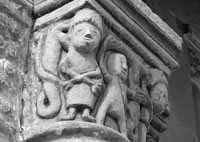 |
1086 | 1088 | H | Rather like Oda, but uses many figures clumped together, each in their own space, very vertical in stance. Often under crockets that frame the corners. Was Odette the teacher of Oda? Arms crossed in front of figure. |
|
|
Old Duke |
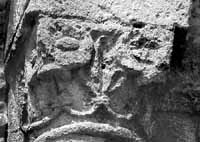 |
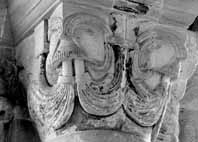 |
1075 | 1103 | r2f H | SEE The Duke, Banniere | Heads in the upper corners, long tendrils emerging vertically from the heads and simple fan-like fronds that for a while became almost recognisable as leaves. Increased use of foliage over 4 or 5 phases. Only human heads. Banniere used similar finger-like foliage at the ends of long stems, and there are occasions when capitals could have been ascribed either way. I made the arbitrary decision that if the upper corner was occupied by a head it was the Old Duke, and if not by Banniere. |
|
Olive |
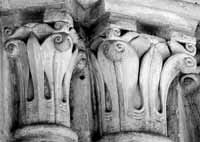 |
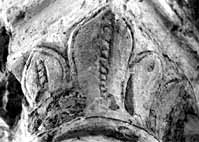 |
1075 | 1166 | 2f <> | SEE The Eye, Loopy | three large plates decorated within; liine of decoration along the top.No veins, unlike Loopy. |
|
Olivier-C |
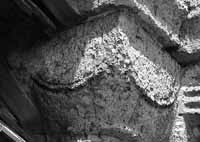 |
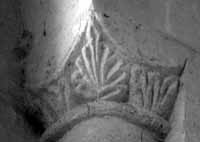 |
1077 | 1158 | cone c | Norman cushion layout with occasional foliage on the underside of the cushion. Increased use of foliage. No creatures. |
|
|
Olivier-T |
 |
 |
1075 | 1182 | tree | Tree-like on simple stalks, always shallow cutting. Foliage more fully formed over time. No creatures. |
|
|
Ouvert |
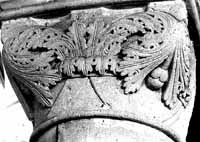 |
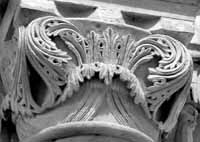 |
1125 | 1168 | tree | could be Fiesta | Open; forms sweep across face with enormous tumbling ends; like a wave. |
|
Palmette |
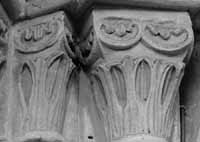 |
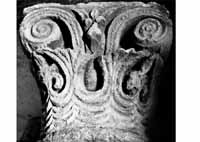 |
1081 | 1165 | 2#+ <> | SEE Palmleaf, Festoon, Isiai | multiple vertical fronds joined at the top. Maybe an offshoot of Palmleaf; lower fronds support unrelated design along the top. |
|
Palmier |
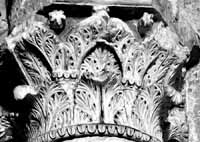 |
 |
1123 | 1164 | tree 2f+ <> | The upper layer of the capital has twin sprays of foliage arching sideways with one central leaf between them, like a palm tree. At the upper corners the spines are split open to create a deep hollow between them. The fronds are supported on a spiral trunk finishing in a rosette-like terminal. Underneath a band of fronds all in the one plane with a smaller leaf between. In later works in an extraordinary move, the small leaf has been split apart, or slid, to reveal the trunk behind. A star was often carved in the centre under the astragal. Leaves have long lozenge-like divisions, deeply incised but little undercutting. No creatures. There is another set of capitals with the same foliage and detailing, but without the palm trees. In one case there are twin birds pecking at a head instead of a star. The later capitals have no lower band of foliage. The detailing is not that of the earlier capitals showing that many carvers were involved, perhaps being when the carver had become a maser mason. Similar forms found in earlier work lead to the south-east, possibly carved while a journeyman. The closest I have found to his work in antique sculpture does not come from Italy or southern France, but from Poitiers |
|
|
Palmier II |
 |
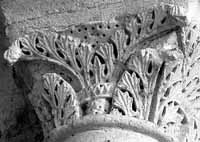 |
1143 | 1158 | tree 2f+ <> | Palmier pupil with his template (even to the drilled spirals in the trunk, and the deep split up the rib), but smaller, sharper leaves, and a surface business not present in the Master. |
|
|
Palmleaf |
 |
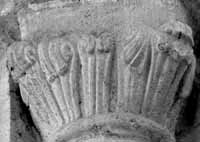 |
1068 | 1185 | 2#+ | SEE Sprout, Daniel | Many vertical separate palm or fern fronds, sometimes in layers.They are in single strips from abacus to astragal, usually turned over at the top. |
|
Paneau |
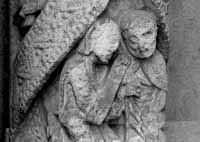 |
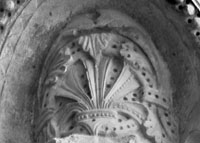 |
1106 | 1160 | r0 | Early work like medallions, single heart-like frames with foliage radiating outwards and tips curled over the edges of the frame. In larger capitals the elements around the frame became more complex, though the basic form remained. OR, as at St-Martin-des-Champs. he allowed the rinceau character found in most of the work of the other carvers to influence what he did. At Chartres in a single shaft folded panels, well-formed figures, possibly just passing through at Chartres. Will be hard to link elsewhere s all we have is figures and decoration. |
|
|
Papillon |
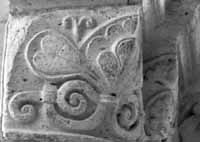 |
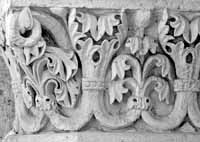 |
1105 | 1145 | r2f <> | Varied designs that are hard to characterise through a single template, though they do seem somewhat overcrowded. His elements are thick vines and free-form fronds, which he seems to have randomly borrowed from the men around him. Vines make the frame that gradually becomes the primary form. Tree-like motifs on the corners of earlier work. All the parts a little bit more rounded that one might usually find. Avoidance of repetition, preferring to create new forms rather than reuse old ones, and comfortable in being asymmetrical. Figures are borrowed from anyone nearby, though placed in his own way. |
|
|
Pascal |
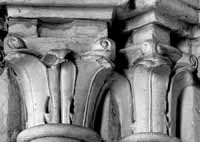 |
1161 | 1171 | 2f+ <> | triple, woven, , tip turned back. The central plate laps over the corner plates with a rounded juntion at the bottom. |
|
||
Patrice |
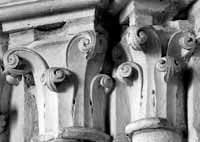 |
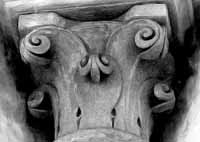 |
1133 | 1165 | 3f+ <> | SEE Pascal | Corner-thin, woven, ,As with Pascal the central plate laps over the corners, but the most significant element is the bulbous hanging crockets with carefully turned-back petals. From the late &#039;50s to the early &#039;60s they display a highly original magnificence. |
|
Pecker |
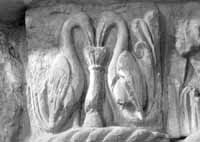 |
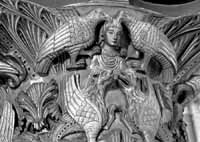 |
1068 | 1161 | Bc+ | SEE Willow | One group has a large head on the corner, flanked by animals pecking or nibbling his ears; in another birds bodies face each other to peck from a head or a goblet with thin bodies and wings down.Wings hug the body, tho different in decorative manner. These are complex designs with many elements cunningly filling the spaces, and with a pervading sense of humour. Nearly always some sort of motif between the birds. In early work the bird is fully rounded by another carver. Birds face inwards. |
|
Pecker II |
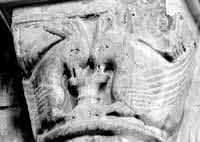 |
 |
1128 | 1165 | Bc+ | Paired birds, symmetrical, with large lizard-tails. Faces each other, large wings point up - big bodies, squat solidity. Birds usually have lizard tails - main characteristic. |
|
|
Peekaboo |
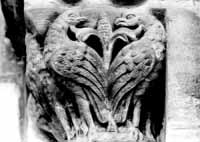 |
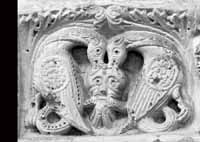 |
1108 | 1162 | Bc | Like Pecker, but bodies turned back to back, with twists that energise the design. The foliage is minuscule, and in later years often fits long pointed fronds over or alongside the birds. Only in St-Germain-des-Pres is there larger foliage, but this is stiff, almost rectangular, and seems to have been dictated by the style of the others carving in this group of piers. Bodies turn, twisted, to sip the nectar. |
|
|
Philibert |
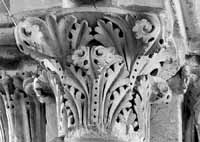 |
1161 | 1161 | 2c+ <> | mid fan, , 2 layers, |
|
||
Philippe |
 |
1161 | 1161 | 2c+ <> | mid fan, , 2 stories, |
|
||
Pierre |
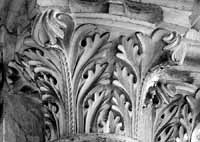 |
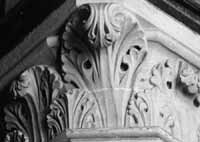 |
1161 | 1161 | 2f <> | corner-fan, no middle, , |
|
|
Pietro |
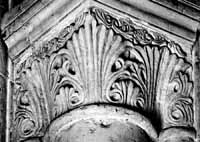 |
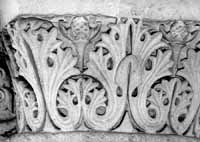 |
1090 | 1165 | 2f+ <> | SEE Abelard Victoire II | Large rising corner leaves with indent half way up. Veins flow round to adjoining frond. Sometimes with crockets. Pending stage 3 of carver analysis. |
|
Pillow |
 |
 |
1072 | 1158 | 2f | The astragal is like a tyre, round in plan and in section. Very uncertain as this motif does not affect the overall template. |
|
|
Pointed |
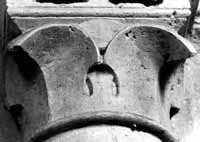 |
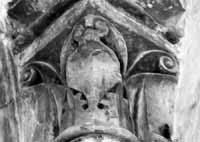 |
1130 | 1173 | 3f+ | PointedHerve, Christophe | deeply curved plates with sharp tips meeting in the middle, just touching. |
|
Posie |
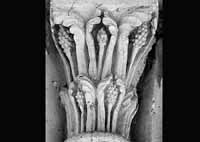 |
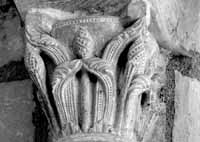 |
1116 | 1168 | 2#+ tree | Bouquet | A pair of thin vertical fronds, at times enclosing an unopened bud, with one pair under the corner; the stalks sit on the astragal. |
|
Prancer |
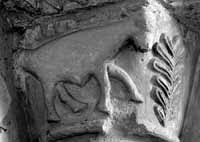 |
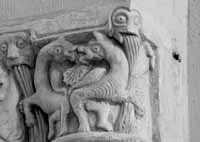 |
1082 | 1144 | H 2c | SEE Oda | Stylised horses and unarticulated bodies in startled poses. Pending stage 3 of carver analysis and more generations. |
|
Rameau |
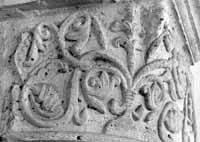 |
 |
1105 | 1143 | r3c H | Fronds wander at whim in loose arrangements of the tendrils that diminished importance of the corners. The vitality in the arrangement comes from an apparent chaos. They are almost never symmetrical, the denial of symmetry being in opposition to most other carvers. Tendrils begin at the base, at times from a large vase, and lap across each other. Leaves fill the spaces, and are large enough to do so. Leaves range from small trefoils to large plates with tips that spiral back like beads, and what I call the stigmata frond. Humans and animals are carved accurately to contain a surprising inner power. Some uncharacteristic work from Normandy may fit into this profile. |
|
|
Rampant I |
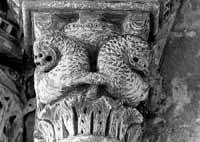 |
 |
1086 | H | Paired animals with large bodies, their legs meeting on the centre of the face and heads turned backwards to support the corners, and a central motif of some sort; a thin tail wound backwards. |
|
||
Rampant II |
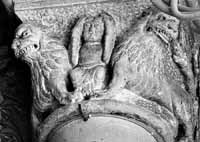 |
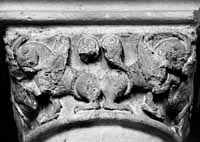 |
1074 | 1164 | H | SEE Siamois, Peekaboo, Stolide before 1130 | Very large paired animals and no other decoration, with twisted bodies and heads that support the corners. Symmetrical in all quarters and paws raised in the centre. Not much change. |
|
Remplir |
 |
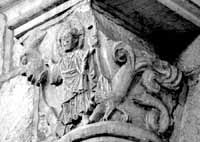 |
1068 | 1135 | geom | Not a group, just some with similar jumbled arrangements put together. |
|
|
Remy |
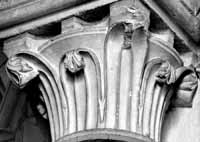 |
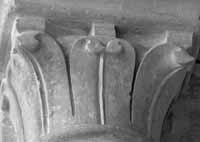 |
1088 | 1161 | 2f <> | Plain surface for triple plates in a columnar arrangement. There is only a thin line between the plates, often marked at the bottom with a small drill hole. Small crockets. In later examples there is a recessed rib up the centre of each plate. Work after the Crusade could easily have been by a pupil. |
|
|
Rocket |
 |
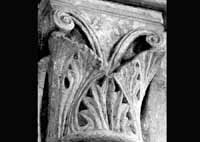 |
1107 | 1167 | 2f+ <> | SEE Roquette, Vertical, Yves | Leaf outlines like Victoire but with a pair of crockets with very thin branches, sitting above the leaves and with plain space between under the astragal. Two-D, single central lower leaf. |
|
Roger |
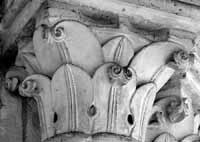 |
1161 | 1161 | 3c+ <> | triple, woven, 2 stories, |
|
||
Romain |
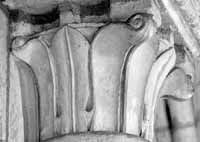 |
1161 | 1161 | 3f <> | triple, woven, , tip turned back |
|
||
Roquette |
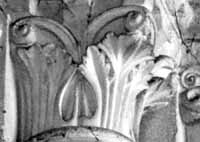 |
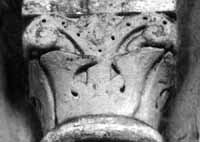 |
1176 | 2f+ <> | SEE Rocket, Umbrella, Yves | Like Rocket except that the straps to the crockets start within an opening or eye between the flanking leaves with pointed corners where they butt one another. The flanking leaves join across the bottom, unlike Yves, so the straps do not sit on the astragal, but emerge from from the flanking leaves or from behind. |
|
|
Routier |
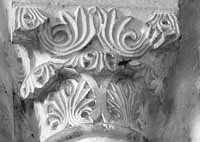 |
 |
1107 | 1158 | 2f+ <> | SEE Sebastien | sharp energized foliage supporting a one-third upper layer of up- or side-thrusting fronds. |
|
Saisons |
 |
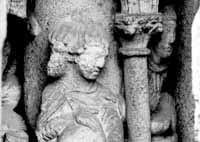 |
1138 | 1138 | H | Distinctive manner, firm figures, simplified foliage and little capitals that are not particularly distinctive. Like Paneau may have been passing through and not much to connect him elsewhere. |
|
|
Sebastien |
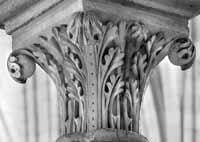 |
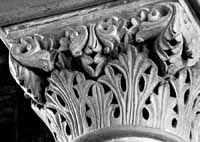 |
1134 | 1161 | 3f+ <> | SEE Routier | corner-fan, woven, openness between leaves, drooping corners, either 3-fold or very open bifold; lower segment flat following curve of the astragal. |
|
Serge |
 |
1161 | 1161 | 3fV <> T^ | corner-thin, woven, , tips up |
|
||
Severin |
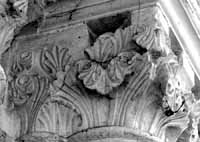 |
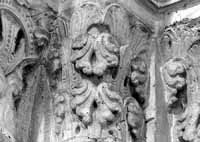 |
1131 | 1165 | 2c+ <>. Tv | SEE Frothy | Large projecting tips, doubled with lower tips pointed in towards each other. These features can be quite bulky; a slightly flyaway look, with the tips turned over and down unlike Sprout; lots of foliage behind so whole of the cone is covered. Hanging leaves where Lazare would be horizontal. The Severin at Laon is later. |
|
Severin II |
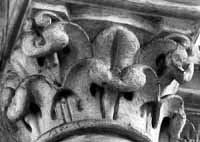 |
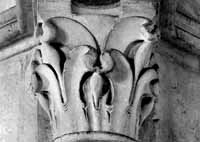 |
1140 | 1171 | 3c <> Tv | SEE Christophe, Lazare | No foliate decoration, plain forms, heavy in mass, hanging ends to fronds with large tops pointing at each other or turned back upwards as in Sens aisles. These terminals droop, and yet the tip turns back up seeking the light, |
|
Siamois |
 |
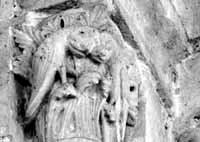 |
1076 | 1162 | H 2c | Generational. Two animal bodies on the faces of the capital joined to a single head at the corner. |
|
|
Skirt |
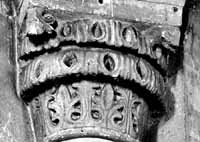 |
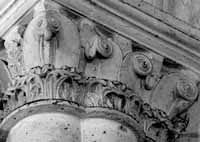 |
1088 | 1164 | 2# | two layers, compelling foliage like waves. |
|
|
Softly |
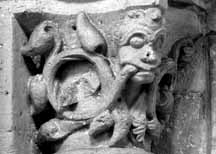 |
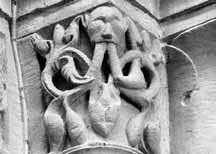 |
1087 | 1157 | r3 H' | Soft tendrils, often held across the mouth as if by the lips. Symmetrical with spirals on each side. Foliage often bulbous. |
|
|
Solo |
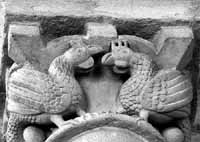 |
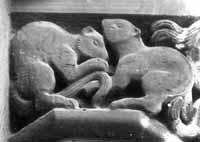 |
1114 | 1164 | H | well rounded animal forms asymmetrically placed and rare foliage, so they occupy the space of the capital on their own. |
|
|
Spiral |
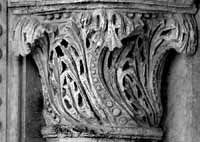 |
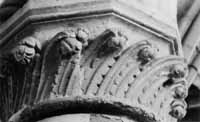 |
1090 | 1198 | twist | spiralled leaves |
|
|
Spirex |
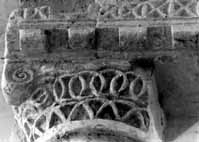 |
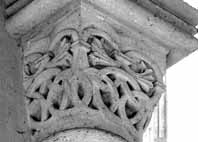 |
1079 | 1112 | geom | Cushion cap in earlier work decorated with a pair of rings that join in the middle; later circles move onto the corners. In the later work occasional motifs of masters with different templates. |
|
|
Sprout |
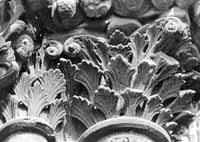 |
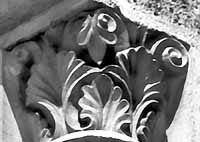 |
1114 | 1161 | 2#+ <> | SEE Frothy, Fanny and Layered. | Sharply outlined triangular leaves, back-cut to create a strong shadow, overlapping by a big margin and largest on the corners. No crockets, no vines. There are two modes (two carvers?). Leaves are arranged in rows, usually two or three rows of them, occasionally up to four, in which the base of the upper row grows out of and behind the lower.Yet each row is 2-D without overlapping. Second group the upper row grows out of the lower with overlapping. It is this three-dimensionality that distinguishes this group from the others. There is no other decoration. The organisation has many followers, Most of the latter do not have a continuous connection between the fronds along the bottom. |
|
SS II |
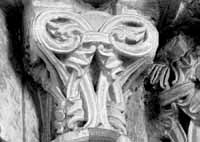 |
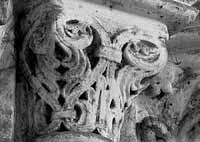 |
1138 | 1164 | r2 | SS Master, GrippleSon | Same layout as older SS Master., and unlike GriooleSon the fronds under the corners are restrained within the tendrils, and the buckles quite small. |
|
SS III |
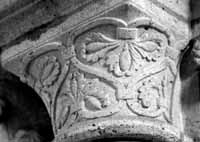 |
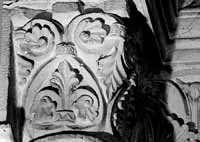 |
1111 | 1155 | r2 oo | SS template used by other carvers |
|
|
SS IV |
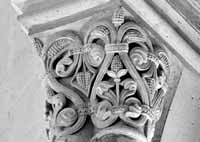 |
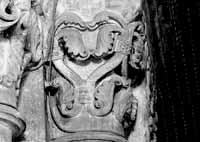 |
1118 | 1161 | r2 oo | SEE SS group | Unlike SS Master, the tendrils descend from the upper corner before opening out and spread from there. The band that ties the tendrils is on the corner, but travels sideways towards the face of the capital, whereas SS drops to hold the fronds. In other words, the curve may have been begun at the bottom corner of the block, whereas SS seems to have begun at the top. Looked at in another way, the major or more generous curves are in the lower part of the capital whereas in SS they are in the upper. The foliage is contained by the tendrils and does not cross over them, compared to Bowline. Later work is fussy and attribution very uncertain. |
|
SS Master |
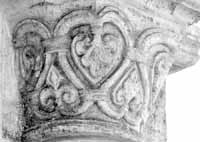 |
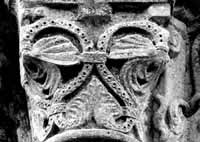 |
1086 | 1138 | r2 oo | Paired symmetrical tendrils in an S arrangement. Each tendril terminates in a bouquet that fills the space between them. The major bouquet hangs under the corner. The tendrils do not cross the framing branches (unlike Andre), and where they meet are often tied with a collar. Layouts have a clear symmetrical geometry along centre-lines and corners. All foliage emerges from the ends of the vines without additional branches. In the earliest branches do not meet at the top, with a large berry in middle, foliage becomes more supple with curled back tips that overlap the tendrils. In time a triangle was added to upper collar. Later used a fleur-de-lys. There is a similar form in a number of archivolts with a pinecone encased in vines that may have been part of the same group. Following this concept back in time provide a number of possible progenitors. Panels and imposts contain similar elements. |
|
|
Stephanie |
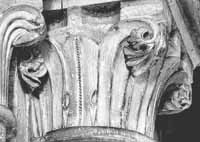 |
1161 | 1161 | 3f <> | triple, woven, , |
|
||
Stolide |
 |
 |
1084 | 1164 | H | SEE Prancer, et al | Large bodies of people or animals occupying whole portions of the space. Neither heads nor bodies are twisted. Underlying sense of humour. Dragons have curled tails. |
|
Strap-X |
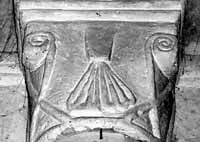 |
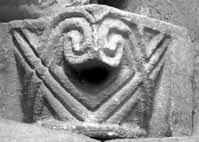 |
1072 | 1124 | X r | Straps and crockets without any foliate decoration, often single threads that are crossed as an X between the astragal and the crockets. Extremely varied detailing, possibly many carvers. No creatures. |
|
|
Strapper |
 |
 |
1120 | 1190 | X <> | SEE Lucien | Weaving two layers of straps ending in whorls. Became incredibly complex during the 1140s, and more aware of the cone in later years. No creatures. Pending stage 3 and 4 of carver analysis. A number of carvers took up this idea for short periods. |
|
Strutter |
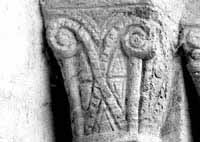 |
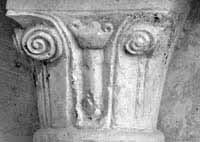 |
1161 | 2x tree | Corner crocket or middle held up by a post. This is another case of an identifiable motif being used occasionally with someone with a more commonly used template. |
|
||
Sylvestre |
 |
1160 | 1161 | 3f+ <> | triple, woven, , |
|
||
The Eye |
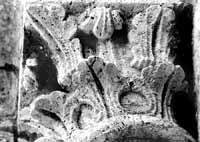 |
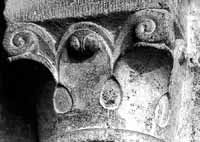 |
1105 | 1197 | 2f+ <> | A large round space left between elements, sometimes with a filler. In later ones this is a major element, by a number of carvers. Geomtetric outline with compas-formed outlines. |
|
|
The Italian |
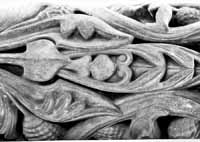 |
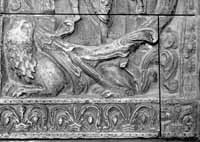 |
1129 | 1132 | H | Very Classical figures in antique poses. figures entwined as with GREGOIRE. Leaf fronds supported by a shield, pointing backwards. |
|
|
The Ram |
 |
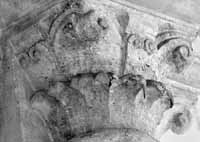 |
1076 | 1128 | H | Massive, almost brutal, designs based on Triad, seldom foliage, but strongly cut symmetrical elements under the corners, some are rams with huge antlers and feet well-planted, some have tails wound around their bodies. |
|
|
Theodore |
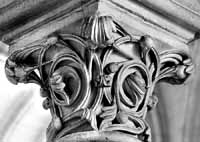 |
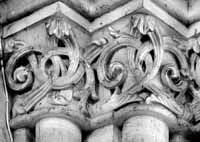 |
1132 | 1176 | r2c Sp X | rinceau |
|
|
Thibaut |
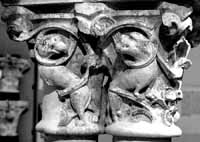 |
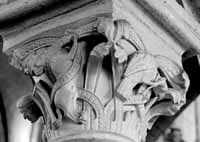 |
1131 | 1170 | r3 H | swirling fronds placed for convenience, not for geometry. animal;s always have tendrils across their bodies. |
|
|
Thierry |
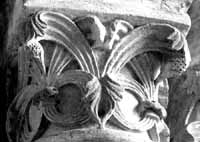 |
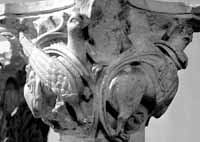 |
1150 | 1169 | r3 H Tv | rinceau |
|
|
Tongue |
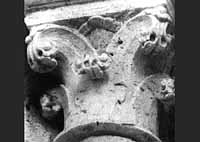 |
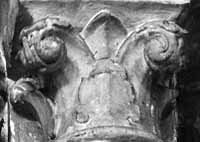 |
1159 | 1188 | 2c ++ | SEE Tung-Long | Simple lateral fronds with over-large crockets and a tongue sticking up at the middle between the two corner leaves. It has serrated edges. In all cases another central leaf dominates the lower register, and gradually develops into the full form of an independent leaf. |
|
Tortue |
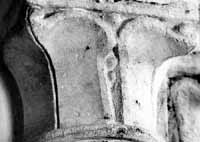 |
 |
1125 | 1182 | 3f | SEE Pointed | Plain leaves in pair or triplet with curve from crocket pushed up to underside of astragal. Little balls may fill spaces. Strong groove for ribs. A very important template, especially from the Challonais. Two-dimensional so the central leaf does not disappear behind the corners. |
|
Treefern |
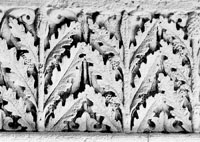 |
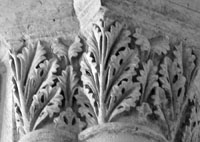 |
1084 | 1158 | tree | Strong vertical trunk with symmetrical ferns pointing upwards on each side. Trunks rise straight out of the astragal, not joined to each other. Usually with a berry at the top. Strong change in quality during the 1120s, suggests a carver and his successor. |
|
|
TreeMan |
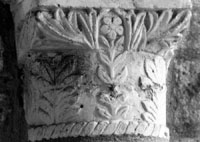 |
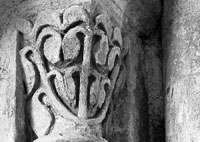 |
1072 | 1164 | tree | Mid trunk with lateral branches under corners; trunks bound together. |
|
|
Triad |
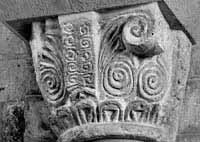 |
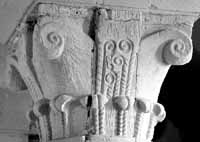 |
1068 | 1091 | 2x # | SEE Etouffant, Apples | Divides the face into three and leaves the central rectangle intact full height. Fan-like decoration within these parts. Softens the centre turning the rectangle into a fluid outline. No creatures. |
|
Tung-Long |
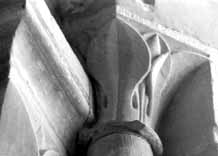 |
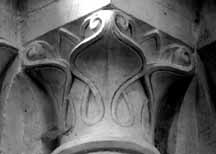 |
1136 | 1173 | 2f+ | See Tongue, Pointed | Long thinnish central plate extended to the astragal, with laterals lapping over it, with a sense of pressure as they close the gap. At times with sharply pointed corners and turned back crockets.The centre for the curve of the upper edge of the flanking plates is raised high, unlike Pointed where it is set down. |
|
Twingo |
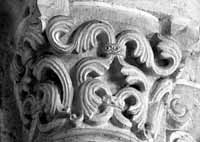 |
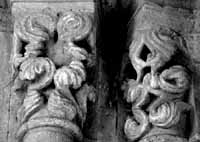 |
1086 | 1167 | 2c wave | many well-designed elements scattered across surface with no upward mpvement, joined and swirling with vines. |
|
|
Umbrella |
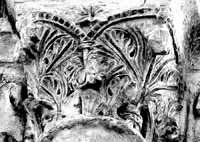 |
 |
1118 | 1167 | r2f+ <> | SEE Rocket | Very definite designs with strongly incised patterns. Highly decorated arms set close to the top, with small crockets placed high up on the capital, as if protecting the foliage underneath, which is continuous and with little overlapping. |
|
Union-J |
 |
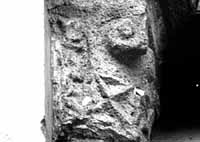 |
1082 | 1111 | geom | Crocket cap with square panels filled with a cross. |
|
|
Urbain |
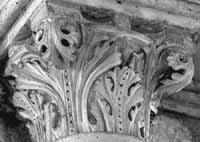 |
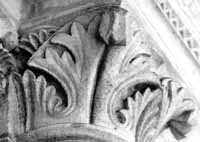 |
1138 | 1164 | 2f+ <>; | corner-fan, , , |
|
|
Valerie |
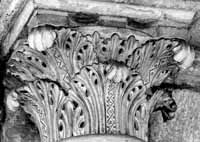 |
1161 | 1161 | 2c+ <> | mid-fan, , 2 layers, |
|
||
Vereaux |
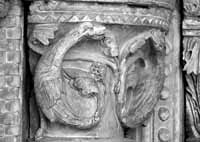 |
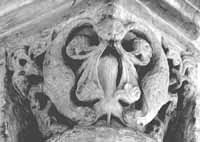 |
1112 | 1165 | Bc | Willow | Paired birds and animals back to back with very foliated tails that fill the space between them; undercut leaves, delicate. Hanging figures, wings up, paired. |
|
Vertical |
 |
 |
1132 | 1180 | 2f <> | SEE Fretter, Lobelia | Clear designs with smaller flanking fronds placed vertically. Rather like Fretter though three-dimensional forms with the central trunk or leaf slipping behind the flanking forms. The outlines are rounded, giving each element a sense of its own thickness. Most have crockets. |
|
Victoire |
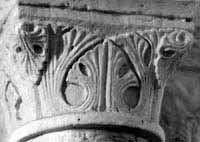 |
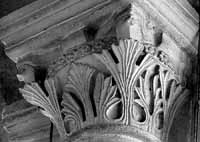 |
1113 | 1156 | 2f <> | Used a standard template, modified where needed. It is the similarities in the shape of the mid-flanking fronds and detailing of the fan-like leaves that connects. He emphasized the gap between. Leaves are joined at the bottom, and in some the veins were curved to form sweeping connections across the base. Major in St-Loup-de-Naud portal. Not much change over the years. No creatures. |
|
|
Victoire II |
 |
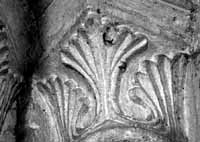 |
1090 | 1165 | 2f <> | Abelard, Pietro | Large leaves all in the same plane, corner widened to support the astragal without crockets, and reaches to the top where the leaf is squared off. Enfolds a large leaf in the centre of the stone. Design becomes more dense with time, but the template remains unchanged. |
|
Victoire III |
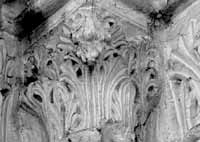 |
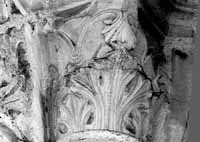 |
1113 | 1145 | 2f+ <> | Like Victoire II but with crockets and other elements under the astragal. They may be the same. |
|
|
Willow |
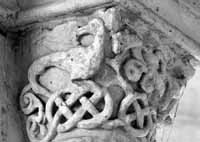 |
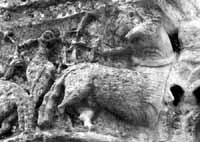 |
1074 | 1168 | H | Vereaux | Detailed figures, well-observed. knots well organised. Better than any by Firedog. |
|
Winger |
 |
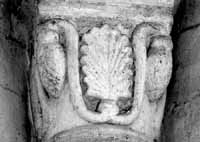 |
1067 | 1133 | r2 | SEE Perplex, Complexitus, Rameau, Spirex-1 | The joiner of the fronds is on the corner and may be quite loose; Fills the space with large decorated elements, enfolded pine cones are common; . A bit like Hooker, but more methodically organised. |
|
Xavier |
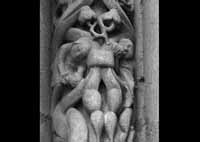 |
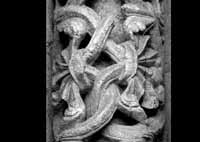 |
1138 | 1139 | r3 | Bulky detailing, with little decoration. Entwined vines that are tightly organised, and deeply undercut. |
|
|
Yannick |
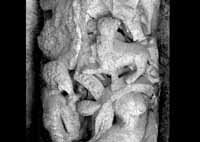 |
1139 | 1139 | H | very like Xavier with complex undercut vines. Boldly simplified figures. |
|
||
Yves |
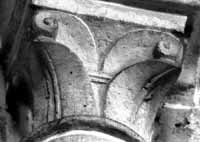 |
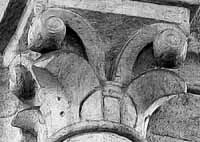 |
1162 | tree 2f+ | SEE Rocket | An abstracted central tree-form that at times acquires additional plates. The trunks arise out of the astragal, the flanking plates at the corners do not join. This work is minimalist, undecorated and reduced to essentials. He sometimes utilises elements from those around him, but never wavers from the simplicity of his original statement. He may have travelled from Normandy and returned ten years later possibly via the Italian border. His work is invariably to the south of Paris, with similarities to Palmier, and I suspect he may have been a monk or lay brother at Saint Martin in Etampes. |
|
|
Yves II |
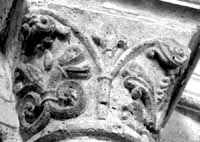 |
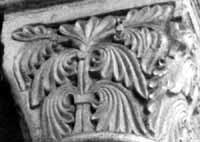 |
1074 | 1144 | tree | SEE Treeman. | Central tree-form with branches. Some have corner trunks and some central. increased use of foliage. No creatures. Pending stage 3 of carver analysis. |
|
Zac |
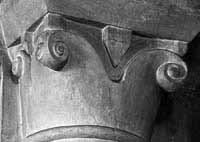 |
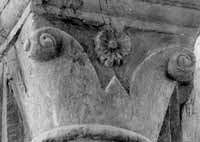 |
1078 | 1139 | 2 | SEE Etouffant | Crocket outline, rounded lower form with corner items and a central piece in the decolletage. |
|
Zacherie |
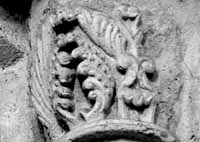 |
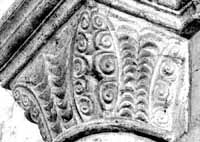 |
1083 | 1167 | 2f | Open element in the corner, wider at the base and coming to a point under the crocket, if there is one. 2-D and unwoven. |
|
|
ZigZag |
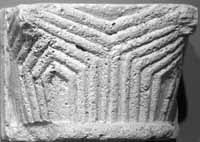 |
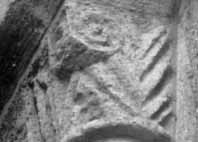 |
1074 | 1121 | geom | zig-zag patterns across the cone-like surface. Sometimes with crockets. |
|